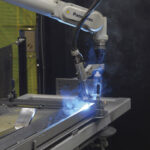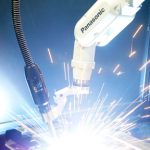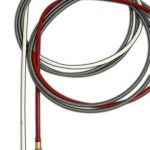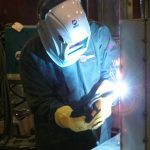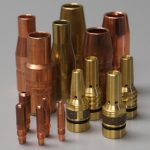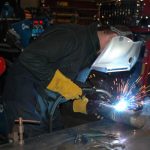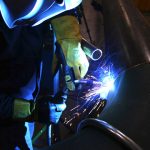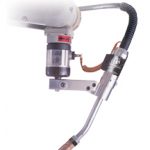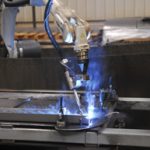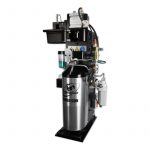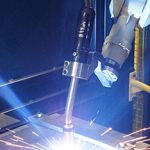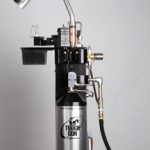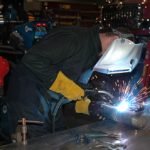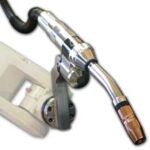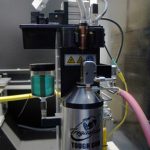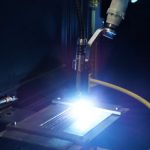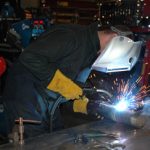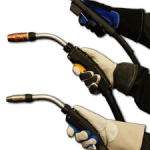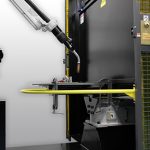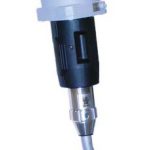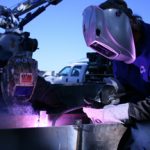Equipment, Training, Maintenance and More: Best Practices for Successful Robotic Welding
The cost to implement welding automation can be substantial, requiring companies to plan out the purchase carefully and to justify the expenditure to the appropriate financial or management personnel. The payback on the investment, however, can be equally beneficial. From productivity increases to quality improvements and cost savings, companies can often position themselves for greater competitiveness in the marketplace by adding robotic welding systems to their welding operation or by replacing manual welding cells altogether.
Unlike companies that employ semi-automatic welding, those with robotic welding systems have the added responsibility of protecting the large capital investment in the equipment. But no two robotic welding systems are the same and likewise, there is no single step to ensure a successful outcome. Rather, a combination of the appropriate planning, equipment purchases and personnel training — among many other things — provides the best results. Paying close attention to the daily occurrences in a robotic welding cell and engaging regularly in some of the best practices discussed here can also help provide high quality results.
Manage parts and workflow
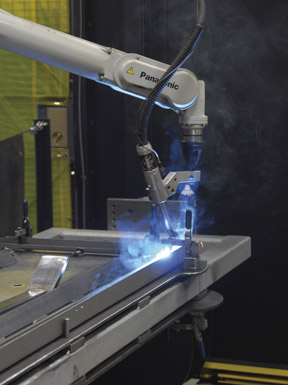
Companies typically invest in welding automation to expedite the welding process, gain more consistent weld quality and/or to reduce costs. The process can also set companies apart from the competition by allowing for faster completion and delivery of products. For companies with high-volume demands and low-variation parts, robotic welding can become an important part of their production plans. Smaller companies with lower-volume, high-variety parts can also benefit, but they may require more flexible tooling and more programming time to accommodate for several types of products.
The important consideration for both high- and low-volume production is to ensure that the parts to be welded lend themselves appropriately to an automated welding process. Robotic welding systems rely on consistent parts to provide consistent results. Companies that have or are planning to implement a robotic welding system need to be certain that parts are simple and repeatable. The presence of gaps, poor fit-up or poor joint access can have a detrimental impact on the high quality sought with robotic welding systems.
Similar to a semi-automatic welding application, consistent workflow is also important for a successful robotic welding operation, with the main difference being the speed at which parts are delivered and welded since a robotic system is so much faster. The parts need to enter and leave the cell at a quicker and steadier rate — without bottlenecks — to gain optimal throughput.
Companies should assess each activity leading up to the part entering the cell, making sure that the supply of parts matches the robot’s cycle time, and also assess the steps for handling the part after it leaves. In some cases, it may be necessary to change how the parts are fabricated upstream and completed downstream (e.g., finishing, painting, etc.) to establish good workflow. Companies should also look to eliminate non-value added activities, including excessive lifting or handling of parts, and avoid multiple trips to stack products or other similar activities.
Protect against premature component failures
Robotic welding systems typically operate at higher amperages and longer duty cycles than semi-automatic welding operations — the robots can withstand the greater arc-on time and heat compared to a human operator. While those increases are excellent for supporting high productivity, the additional heat and welding duration can be especially harsh on consumables — nozzles, contact tips and gas diffusers (or retaining heads).
Companies need to take steps to avoid the pitfall of excessive consumable changeover. Entering the weld cell for purposes other than part changeover or routine pauses in the operation can add unnecessarily to downtime, which can easily add up per shift, day, month and year, resulting in lost productivity. Excessive consumable changeover is also costly, as it increases inventory and inventory management.
There are two key steps companies can take steps to increase consumable life in their robotic applications and reduce downtime. One, install consumables properly and maintain tight connections throughout the course of welding. Loose connections increase electrical resistance, causing the consumables to generate additional heat that can shorten their lifespan and/or cause them to perform poorly. Follow the manufacturer’s instructions for proper consumable installation, taking care to tighten the consumables appropriately. It’s also a good idea to check the consumables periodically during routine pauses in welding, as they can loosen throughout a shift.
Two, install the robotic MIG gun liner properly, as this helps prevent downtime to address wire feeding issues or to correct a burnback, in which the wire “burns back” into the contact tip. Follow the manufacturer’s instructions for trimming and installation, using a liner gauge to confirm the correct liner length.
Preventing premature power cable failure, which can occur in both through-arm robotic welding systems (where the cable feeds through the arm of the robot) or in standard robotic welding systems (also referred to as over-the-arm) is also important. Be mindful of the path the robot has been programmed to follow, the speed at which it moves and the cable length. The power cable should clear the robotic arm and tooling to prevent it from catching or rubbing against either part. Also, the robot should be programmed not to move too fast or abruptly. Aggressive movements can cause the power cable to snap. Make sure that the cable is the appropriate length — too short of a cable can stretch beyond its capacity during routine robotic movements, leading to greater wear. If the power cable is too long, it may be prone to kinking or becoming pinched by the robot’s arm.
Don’t neglect maintenance?
Preventive maintenance (PM) programs are among the most effective best practices a company can instill for a robotic welding system. Ideally, PM programs should cover every aspect of the system — from the robot to the contact tip. Proper PM activities can help prevent unscheduled downtime, low quality parts, costly repairs and/or equipment replacements.
Companies will need to assess their PM needs on an individual basis and engage a maintenance team or other personnel to carry out the activities at the appropriate times and intervals. As a general rule, companies that weld thick materials or have applications with long, continuous welds common in welding automation can benefit from more frequent PM activities, as the rework for quality issues can generate much more costly rework compared to an application producing multiple smaller parts. Several PM activities can occur during routine pauses in production, including:
• Cleaning the robot and fixturing to prevent the buildup of dirt, debris or anti-spatter compound, which could affect part fit-up.
• Checking for tight consumables connections.
• Confirming tool center point or TCP (discussed in more detail later).
• Checking for power cable wear and replacing as needed.
Other activities that happen less frequently like greasing the robots joints can be completed during a longer scheduled stop.
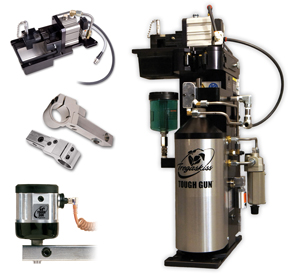
Always consider peripherals and robotic MIG gun extras
Peripherals are often an overlooked part of the robotic welding system. The added cost of this equipment, which includes nozzle cleaning stations (also called reamers or spatter cleaners), is frequently considered an unnecessary expense. In reality, this equipment can maximize robotic welding performance and help companies gain a better return on investment (ROI) from their robotic welding system.
As its name suggests, a nozzle cleaning station cleans the nozzle of dirt, debris and spatter, typically during routine pauses in the robotic welding operation. The goal of this cleaning action is to help ensure consistent shielding gas coverage, and with it, reduce weld defects, expensive rework and lost productivity. A nozzle cleaning station also helps extend the life of consumables, minimizing the downtime and expense for changeover.
For the best results, the nozzle cleaning station should be mounted in close proximity to the robot to reduce the amount of time necessary for its arm to reach it. Companies can mount the peripheral overhead if need be. The robot should be programmed to clamp onto the nozzle cleaning station at a taught position exactly perpendicular to the cutting blade that clears out the spatter or other debris. Any misalignment to the position of the nozzle could lead to partial cleaning of the nozzle and excessive spatter build-up. Program the robot to go to the nozzle cleaning station as often as possible; the cleaner the consumables are, generally the better performing and longer lasting they will be.
For companies who choose to attach an anti-spatter sprayer, it’s important to locate the spray in the appropriate position so it completely coats the inside of the nozzle. Ideally the outside should be covered to within three-quarters of an inch from the bottom of the nozzle.
Other peripherals that companies can integrate into their robotic welding system include a wire cutter and a neck inspection tool (discussed in the next section). A wire cutter cuts the welding wire to a specified length, removing any inconsistencies at the end, providing for more reliable and smoother arc starts and better seam tracking for robots featuring that technology. For companies using touch sensing software, using a wire cutter in conjunction with a robotic MIG gun featuring a wire brake can help prevent problems with seam tracking. Touch sensing allows the robot to store position data and send electrical impulses back to the controller once it has located the joint. For applications that have slight variations in parts, touch sensing helps maintain weld consistency. It is also more cost-effective than investing in new tooling and fixturing to hold a part in a precise location; if the part moves slightly, the robot can still locate the joint and weld accurately, as long as the joint has well-defined edges. Using a wire cutter can ensure the wire is cut to a consistent length; the wire brake holds the wire in a set position as the robot articulates and searches for the weld joint, ensuring more accurate touch sensing readings for more consistent weld quality.
Stay on target
For a robot to be repeatable and provide consistent welds, it is important for the system to maintain its tool center point or TCP, which is the focal point of the robotic MIG gun and its relationship with the position of the welding wire in the joint (gun-to-work distance).
Typically, but not always, TCP issues occur after a collision, during which the neck of the robotic MIG gun becomes bent. To rectify the issue, welding operators can employ a peripheral called a neck inspection tool (or neck-checking tool) to bend the neck back to the proper angle. Most neck inspection tools are designed to accommodate standard necks for a particular brand of robotic gun. To use this peripheral, the welding operator or maintenance personnel needs to determine the tolerances for the robotic welding program and adjust the bent neck to meet the correct specifications.
To maintain TCP, it is also important to install the robotic MIG gun neck properly, making sure it is fully seated. If not, it will extend too far and can cause TCP to be compromised. Programming the robot for a TCP check to verify proper position can also help prevent against quality issues and potential downtime.
Another best practice to help ensure on-location welds is to check that fixturing is in the correct place, that it doesn’t allow the parts to move and that the base of the robot is securely in place. Periodically check that part variation hasn’t changed, as well.
Find the right people
Designing parts for automation, managing workflow, selecting the right equipment and implementing a consistent PM program mean nothing if companies don’t have the right personnel in place to work with and/or oversee the robotic welding system. Investing in the people who are responsible for interacting with the robotic welding system should always be a priority.
Skilled welding operators or employees with previous robotic welding experience are often a good choice for overseeing a robotic welding system. The personnel should undergo the proper up-front training before taking on the responsibility of working with the robotic welding system — loading and unloading parts and programming the robot for instance. Robotic welding integrators and robot manufacturers can often provide OEM-based training and continuing education. The goal is to instill the skills necessary not only to work with the robot on a daily basis, but also to be able to hone troubleshooting skills that can promote the maximum uptime in the robotic welding cell. These individuals can also be part of the PM programs mentioned earlier.
Protecting the investment
As with any capital investment, companies need to take the appropriate steps to protect their robotic welding system. Whether it’s the addition of peripherals or implementing additional training, engaging in a few best practices can help companies gain a solid payback on the equipment, empower employees to be part of the company’s success and establish the robotic welding system as a profitable part of their business. The items discussed here are by no means exhaustive. Companies can seek out ideas for improving their operation from other, non-competitive companies, or work with a trusted welding distributor or robotic integrator for further options.
Robotic welding systems can provide many companies with increased productivity, improved quality and reduced costs — important and differentiating benefits in the fabrication and manufacturing world. However, simply implementing a robot or two isn’t enough to maximize such benefits. Organizations must understand where they should focus their resources to achieve the most gain. To help remain competitive, companies need continually to look for ways to increase throughput in their overall robotic welding process, while also keeping costs low and quality on par. But given the demographic changes taking place throughout the welding industry — many companies are seeing more turnover in management as longtime supervisors retire and new leaders join the ranks — some managers may not have as much experience with robotic welding systems. Determining how to keep the welding operation functioning in the most efficient, productive and profitable manner may become an intimidating task. This article discusses four key strategies to help welding managers, particularly those new to the job, maximize throughput in robotic welding applications. One of the first steps in improving throughput in robotic welding applications is streamlining in-house processes from beginning to end, to minimize the number of non-value-added activities. Streamlining begins with establishing a clear understanding of the entire production process as it currently functions. Issues to consider include: how long it takes to make a part; how long it takes for a part to go through the entire system; how many machines run at once; how many machines run at full capacity; floor space utilization; how often the part is handled; and proximity of components to the process areas. Gathering this kind of data is helpful in establishing baselines. Once there is an understanding of the entire process, welding managers can start looking for areas to improve. Many of the variable costs in manufacturing come from the process of actually putting products together, so reducing or eliminating non-value-added activities in this part of the process can help to reduce costs. Understanding how much time it takes for a component to move through the entire production process also can reduce the volume of inventory waiting to be processed, which saves costly space. It may also minimize some of the labor used to manage inventory, allowing it to be dedicated elsewhere in the welding operation to help improve the process. Another way to become more efficient in robotic welding processes is to seek out other manufacturers or industry experts who have had success in this area. Find another manufacturer that produces similar products (but is not a competitor) and observe their facilities and production processes. Look for these opportunities with companies known for strength in efficient fabrication or manufacturing, and ones that are gaining success in their robotic welding applications. In short, finding resources that are comparable and appropriate can help with the process of benchmarking areas for improvement. Managers also can capitalize on relationships with industry colleagues and connect with other experts via professional organizations and societies. These networking opportunities can offer good resources for industry knowledge and best practices that can then be applied within the robotic welding process. Managers may also find it useful to seek advice on best practices from the manufacturer or the integrator of the robotic welding system or products (such as robotic MIG guns, consumables or peripherals). These sources often have information to provide about integrating the products with existing equipment or investments that can be made to improve throughput. Another important step for increasing throughput in robotic welding processes is understanding what the key cost drivers are. Understanding the fixed costs and the variable costs in each step of the process enables managers to identify the key cost drivers in the complete production process. Once they have identified and measured the key cost drivers, managers can use that information to decide where to focus attention for improvement efforts to get the biggest impact. This approach can help companies become more efficient and effective operations. Some of the questions to consider when conducting a detailed analysis of cost drivers in manufacturing and fabrication include: how much it costs to produce a part; the time required to perform an activity; how much it costs for equipment maintenance; and how much it costs in lost productivity if equipment is not functioning properly. A detailed analysis of cost drivers also can help a company identify non-value-added activities, such as grinding, cleanup and part movement, and how much time is spent on those activities. This analysis is another step in deciding where improvements can be made to make the most impact on throughput. The purpose of a detailed analysis that looks at time and costs is to clarify and measure cost drivers, with the aim of developing a strategy to improve productivity. Companies can spend a lot of time and effort to measure costs and processes, and develop solutions to improve efficiencies, but may overlook the next key steps: actually following through with the improvement plans and then measuring those accomplishments. Managers may think of improving throughput as an event, when really it’s a process. Hatching good ideas and formulating solutions is important, but implementing those plans and then revisiting them for periodic review is just as important. The bottom line is managers should ask, “Are we actually doing what we said we would do, and is it working?” Implementation is most effective when it happens as a collaborative effort, rather than as a top-down mandate from management. Involve employees from the plant floor up through company management when formulating initiatives. This kind of widespread involvement and buy-in is necessary for continuous improvement and for change to successfully occur. After collaborative implementation, it’s important to follow up with an effective way to easily measure the efforts. An effective measurement strategy helps verify if the implemented processes are paying off. Following a “plan-do-check-act” model of continuous improvement can help manufacturing and fabrication facilities improve throughput in robotic welding applications.
MIG gun consumables, including the liner, can make significant difference in gun performance and weld quality. A MIG gun liner spans from the front of the gun through to the power pin and is the conduit through which the welding wire feeds. Proper installation of the liner is critical to its ability to guide the wire through the welding cable and up to the contact tip — and to help an operation avoid the many problems that can result from improper liner installation, such as birdnesting, wire feeding issues and increased debris in the liner. There are numerous liner types available that are usable for both semi-automatic and robotic applications. Choosing one is often up to the preference of the welding operator or maintenance personnel. Each type has advantages and disadvantages for specific applications in robotic and semi-automatic welding and can offer compatibility with varying gun styles and sizes. The three main categories of liner types are conventional liners, front-loading liners and front-loading liners that have a spring-loaded module to accommodate for up to 1 inch of forgiveness for improperly trimmed liners. Conventional liners are installed through the back of the gun and are longer than the cable, often up to 25 feet long. These are frequently used in the industry; so many welding operators are familiar and comfortable installing this type of liner. A disadvantage of conventional liners is the lengthy changeover process. In the cases of liner replacement, this may require the welding operator to climb over robotic tooling or transfer systems to remove the gun from the wire feeder. In the case of semi-automatic MIG guns that are connected to boom-mounted feeders, the welding operator may need to climb several feet into the air to change liners. Another disadvantage of conventional liners is that they can’t account for changes in length as the cable grows and shrinks with twisting (due to the fact that MIG gun cables are wound in a helix pattern). This can lead to the liner not being seated properly inside the retaining head. Front-loading liners are, as the name implies, installed from the front of the gun. This offers timesaving advantages, since the welding operator does not have to leave the front of the gun for changeover, which can reduce downtime. Front-loading liners have the same disadvantage as conventional liners, since they can’t grow or shrink with the cable as it twists and moves. Jump liners are a type of front-loading liner-. Whereas standard front-loading liners are full length, jump liners are shorter — often about 1 foot long — and replace only the part of the liner that wears the quickest, typically at the neck of the gun. The third main category is front-loading liners that have a spring-loaded module inserted into the power pin, allowing for up to 1 inch of motion as the cable twists and springs up and down. This type of liner tends to be more forgiving if the liner is trimmed incorrectly. Choosing the right type of liner for the application can help an operation avoid feeding issues and reduce downtime. While welders may have a preference on liner type, be aware that each type of liner has advantages and disadvantages for specific applications and can offer compatibility with varying gun styles and sizes.
MIG gun consumables are often one of the most overlooked portions of the welding operation. However, choosing the right consumables, and using and maintaining them properly can make a significant difference in gun performance and weld quality. Consumables comprise the front-end part of the gun and include the nozzle, retaining head, contact tip and liner. A MIG gun liner spans from the front of the gun through to the power pin and is the conduit through which the welding wire feeds. Proper installation of the liner is critical to its ability to guide the wire through the welding cable and up to the contact tip. Improper liner installation — which includes trimming the liner too short or having a liner that is too long — can lead to a number of problems, such as birdnesting, wire feeding issues and increased debris in the liner. These issues can result in costly rework and operator downtime for maintenance and repairs, which impacts productivity. Also, wasted wire due to issues like birdnesting can drive up costs for a company. There are several liner types available for semi-automatic applications. Choosing one is often up to the preference of the welding operator or maintenance personnel. Each type has advantages and disadvantages for specific applications and can offer compatibility with varying gun styles and sizes. Conventional liners are installed through the back of the gun and are longer than the cable, often up to 25 feet long. These are frequently used in the industry; so many welding operators are familiar and comfortable installing this type of liner. A disadvantage of conventional liners is the lengthy changeover process. In the cases of liner replacement, this may require the welding operator to climb over robotic tooling or transfer systems to remove the gun from the wire feeder. In the case of semi-automatic MIG guns that are connected to boom-mounted feeders, the welding operator may need to climb several feet into the air to change liners. Another disadvantage of conventional liners is that they can’t account for changes in length as the cable grows and shrinks with twisting (due to the fact that MIG gun cables are wound in a helix pattern). This can lead to the liner not being seated properly inside the retaining head, resulting in wire chatter and feeding issues. Front-loading liners are, as the name implies, installed from the front of the gun. This offers timesaving advantages, since the welding operator does not have to leave the front of the gun for changeover, which can reduce downtime. Front-loading liners have the same disadvantage as conventional liners, since they can’t grow or shrink with the cable as it twists and moves. Jump liners are a type of front-loading liner. Whereas standard front-loading liners are full length, jump liners are shorter — often about 1 foot long — and replace only the part of the liner that wears the quickest, typically at the neck of the gun. Front-loading liners that have a spring-loaded module inserted into the power pin allow for up to 1 inch of motion as the cable twists and the liner moves forwards and backwards. This type of liner reduces the opportunity for gaps at the front of the gun and helps to compensate if the liner is trimmed too short. Systems like the Bernard® AccuLock™ S Consumables for semi-automatic MIG guns feature a nozzle, contact tip, diffuser and liner design that work in conjunction to provide error-proof liner installation and replacement. The AccuLock™ S Liner loads through the neck at the front of the gun, then is locked and concentrically aligned to both the contact tip and power pin. The liner is then trimmed flush with the power pin — no measuring required — and reinstalled to the wire feeder. This eliminates gaps and misalignments at the front and back of the MIG gun liner for flawless wire feeding. The installation process is somewhat similar for all three types of liners, with some variations. Here are some general steps to consider when installing a new MIG gun liner. These steps are the same for both semi-automatic and robotic MIG guns: 1. Before removing the consumables, make sure the gun is straight and the cable is flattened. This makes it easier to feed the liner all the way through. 2. Trim the wire at the front of the gun to remove the bead of molten wire that often forms after welding. 3. Remove all of the front-end consumables so the liner can be fed through the gun. 4. For a conventional liner installation, remove the power pin from the feeder at the back of the gun and cut the wire. This allows the wire and a conventional liner to be removed from the back of the gun. 5. If using a conventional liner, feed the liner through the back of the gun, threading it into the power pin. Reinsert the power pin back into the feeder, and feed a few inches of wire through the back of the power pin. That way, once all of the consumables are back on at the front of the gun, the wire is already in the gun and ready to be pulled through. (See below for variations for front-load liners and front-load liners with spring-loaded modules) 6. Because the liner is longer than the gun assembly (designed to accommodate varying gun and cable lengths), there will be a foot or so of liner sticking out the front of the gun, so it’s necessary to trim the liner to the correct length. Conventional liners and front-loading liners often come with a plastic liner gauge that has a 3/4-inch stick-out. This can be fed over the top of the liner and pressed up flush against the neck, so the liner can be trimmed to the end of the gauge. 7. Hit the trigger, to pull the wire up, and at the same time purge the gun with shielding gas. There are some variances in the installation process, depending on liner type. Here are some differences to note: • When installing a front-loading liner, unravel the liner (which comes coiled) and stick the brass end — the end that goes into the receiver at the back of the gun — over the wire and through the neck. Feed the liner through the front of the gun using short strokes, to avoid kinking the liner. The front-loading liner will click or snap into place once it hits the receiver in the power pin. Once that is complete, put the liner gauge on top of the liner and follow the standard installation steps above. • When installing a front-loading liner with the spring-loaded module, the only difference is that there is no receiver in the back of the power pin. The receiver is built into the module pin. While feeding the front-loading liner into the gun using short strokes, the liner will engage with the receiver inside of the module’s power pin. When this happens, the welding operator can feel the liner spring back toward the front of the gun. This is a good sign, because it means the liner is properly engaged. Place the liner trim gauge over the front-loading liner until it is flush against the neck. Push the liner back into the gun until it bottoms out against the spring-loaded module, then trim the liner flush to the end of the liner trim gauge. After trimming, remove the liner trim gauge and release the liner. Note that the liner will spring back and stick out of the neck by approximately 1-3/4 inch, which is normal, as installing the consumables will compress the liner into its proper position. The installation process also varies when retrofitting a gun from a conventional liner to a front-loading liner, or when completing a liner changeover, as compared to installing a new liner in a new gun. When it’s not the first time the liner is being installed, there are a few additional things to remember: • When retrofitting a gun from a conventional liner to a front-loading liner, the first installation will be from the back of the gun, since a receiver is needed on the back in order to accept the front-loading liner. • After following all of the standard steps above and removing the conventional liner and wire from the gun, install the end of the front-loading liner with the O-rings on it into the receiver and unravel the liner. Feed the front-loading liner in, just as with a conventional liner, through the back of the gun, and thread the receiver into the power pin. When installing a liner as part of the AccuLock S Consumables Series, follow the same steps as when installing other types of liners, removing the front-end consumables and old liner. Then replace the new liner through the neck, and with the gun lying straight, push the liner through until the brass liner lock bottoms in the neck. To lock and center the liner, reinstall the gas diffuser and nozzle, and place the power pin cap over the liner, torquing it to 60 in-lbs (7Nm). Then simply trim the liner flush with the power pin at the back — no need to measure the liner. The quality of the liner also can impact welding performance, productivity and operator downtime, so it’s important to buy quality liners from a trusted manufacturer. Choosing the correct size of liner for the wire being used is another way to help maximize performance. While liners may seem like a small part of the welding operation, it’s important to be mindful of the impact they can have on quality, performance and costs. Liners perform a vital function in the MIG welding process, and the proper installation and maintenance of liners can help reduce costly rework, operator downtime and wasted wire.
Welding is a tough business requiring equally tough equipment. When it comes to high amperage applications that is especially true. Applications exceeding 300 amps generate a large amount of reflective heat from the arc, making it necessary to have front-end consumables — nozzles, contact tips and gas diffusers — that can withstand the course of welding, whether it’s a semi-automatic or robotic application. Such applications are particularly common in industries such as heavy equipment manufacturing, where the material thicknesses are greater and therefore require the higher amperages to create quality welds. In some automotive applications that employ robotic welding systems, amperages can also fall into that same high level. The right consumables can help in high amperage applications in a number of ways.
The MIG welding process offers many benefits for various applications and industries, including fabrication, manufacturing and general maintenance. It’s one of the easiest welding processes to learn and offers good control on thin metals. Because MIG welding uses a spool to constantly feed a wire through a welding gun, it doesn’t require frequent stopping as with stick welding. This feature makes it an efficient process that offers faster travel speeds and productivity benefits. The versatility and speed of MIG welding also make it a good option for all-position welding on various metals, including mild and stainless steels and aluminum, in a range of thicknesses. In addition, it produces a cleaner weld that requires less cleanup than stick or flux-cored welding. Selecting the right gun for the job is important to achieving good results and realizing all of the benefits MIG welding can provide. The choice of gun can have a significant impact on productivity, downtime, weld quality and operating costs, not to mention welding operator comfort. This article discusses the options to consider in selecting the appropriate MIG gun for the job. Amperage and duty cycle rating are both important considerations, but keep in mind that when it comes to amperage, bigger isn’t always better. Selecting a larger amperage gun than necessary for an application can cost money upfront and cause operator discomfort due to the increased weight, which can result in unnecessary downtime. Welding operators are often better off selecting the smallest amperage gun possible for the application, to provide them with a lighter-weight, more flexible gun that can reduce fatigue and associated downtime. Lower amperage guns also typically cost less. Duty cycle refers to the number of minutes in a 10-minute period that a gun can be operated at its full capacity without overheating. For example, a 60 percent duty cycle means six minutes of arc-on time in a 10-minute span. Because most welding operators don’t weld 100 percent of the time, it is often possible to use a lower amperage gun for a welding procedure that calls for a higher amperage one. A lower amperage MIG gun should still be capable of operating at the necessary capacity, while also offering the benefit of being easier to maneuver. That improved maneuverability can help improve weld quality and reduce the need for rework. While a lower amperage gun is appropriate for some applications, be sure the gun offers the necessary welding capacity for the job. Overworking a light-duty MIG gun can lead to premature failure. It’s also important to consider if a facility has multiple applications that make it necessary to have a gun that can handle various amperage needs. A light-duty MIG gun is often the best choice for applications that require short arc-on times, such as tacking parts or welding sheet metal. Light-duty guns typically provide 100 to 300 amps of capacity, and they tend to be smaller and weigh less than higher duty guns. Most light-duty MIG guns have small, compact handles as well, making them more comfortable for the welding operator. Light-duty MIG guns offer standard features at a lower price but typically need to be replaced more frequently. They also often use light or standard duty consumables (nozzles, contact tips and retaining heads), which have less mass and are less expensive than their heavy-duty counterparts. The strain relief on light-duty guns is usually composed of a flexible rubber component and in some cases may be absent, causing the opportunity for kinking that may lead to poor wire feeding and gas flow. Also, some unicables on light-duty MIG guns have crimped connections and may not be able to be repaired, requiring replacement of the cable or possibly the entire gun. Welding operators should watch for these potential issues. At the other end of the spectrum, heavy-duty MIG guns are often the best choice for jobs that require long arc-on times or multiple passes on thick sections of material, including many applications found in heavy equipment manufacturing and other demanding welding jobs. These guns generally range from 400 to 600 amps and are available in air- and water-cooled models. They often have larger handles to accommodate the larger cables necessary to provide the higher amperages. The guns frequently use heavy-duty front-end consumables that are capable of withstanding high amperages and longer arc-on times. The necks often are longer as well, to put more distance between the welding operator and the high heat output from the arc. When using a heavy-duty MIG gun, choosing between a water- or air-cooled model depends largely on the application and amperage requirements, operator preference and cost considerations. Applications that involve welding sheet metal for only a few minutes every hour have little need for the benefits a water-cooled system can provide. Whereas shops with stationary equipment that repeatedly weld at 600 amps likely will need a water-cooled system to handle the heat of the application. A water-cooled MIG welding system pumps cooling solution from a radiator unit, usually integrated inside or near the power source, through hoses inside the cable bundle and into the gun handle and neck. The coolant returns to the radiator where a baffling system releases the heat absorbed by the coolant. The ambient air and shielding gas further disperses the heat from the welding arc. Water-cooled guns range from 300 to 600 amps. An air-cooled system relies on the ambient air and shielding gas to dissipate the heat that builds up along the length of the welding circuit. These systems, which range from 150 to 600 amps, use much thicker copper cabling than water-cooled systems. Each system has advantages and disadvantages. Water-cooled guns are more expensive up-front and can require more maintenance and operational costs. However, water-cooled guns also are much smaller and lighter than air-cooled guns, so they can provide productivity advantages due to reduced operator fatigue. Because water-cooled guns require more equipment, they can be impractical for applications that require portability. A MIG gun’s handle, neck and power cable design can all impact how long an operator can weld without experiencing fatigue. Handle options include straight or curved — both of which come in vented styles — and the choice often boils down to welding operator preference. A straight handle is the best choice for operators who prefer a trigger on top, since curved handles for the most part do not offer this option. With a straight handle, the neck can be rotated to place the trigger on top or on bottom. In heavy-duty applications, some welding operators drape the power cable over their shoulder, and in those cases a trigger on top is more accessible. When it comes to cable selection, smaller, shorter and lighter power cables can offer greater flexibility, making it easier to maneuver the equipment and avoid clutter in the workspace. Manufacturers offer cables ranging from 8 to 25 feet long, and shorter cables often contribute to better feedability of the wire. The longer the cable, the more chance it can get coiled around things in the weld cell or looped on the floor and possibly disrupt wire feeding. However, sometimes a longer cable is necessary if the part being welding is very large. Other options to consider are the addition of a heat shield, which protects the welding operator from the heat output of a high amperage MIG gun and allows for longer arc-on time. Adding a unicable cover can protect the power cable from a harsh environment. Just as with standard MIG welding, self-shielded flux-cored welding (FCAW-SS) can offer high productivity and quality advantages in certain fabrication applications, while also providing easier training and operation. Many of the considerations for selecting a FCAW-SS gun are similar to those for selecting a standard MIG gun. Amperage and duty cycle ratings and the application requirements remain among the most important elements to consider in selecting either type of gun. Here are some issues to keep in mind for self-shielded FCAW-SS gun selection: • Operators can choose between a fixed liner and a replaceable liner, which (as the name suggests) can be replaced if it becomes clogged or damaged. • Guns with fixed liners typically have external trigger leads, while guns with replaceable liners commonly have trigger leads internal to the power cable, which prevents catching on surrounding equipment. This can be a consideration for applications that require welding around hard corners or fixtures. • Trigger options include standard or dual-schedule to allow welding operators to increase or decrease wire feed speed at the gun with the flip of a switch. Minimizing fatigue, reducing repetitive motion and decreasing overall physical stress are key factors that contribute to a safer, more comfortable and more productive environment. Choosing a MIG gun that offers the best comfort and operates at the coolest temperature allowed by the application can help improve productivity and, ultimately, the profitability of the welding operation by increasing arc-on time.
Taking into account the heat, the repetitive motions and the sometimes cumbersome equipment, gas metal arc welding (GMAW) can sometimes take a toll on welding operators in the form of aches, fatigue, and physical and mental stress. But there are tools and accessories that promote a more comfortable environment and minimize downtime. A welding gun’s handle, neck and power cable design all can significantly impact the duration of time a welding operator can weld without experiencing fatigue or stress. This article discusses some things to consider that can help optimize comfort and productivity and, ultimately, the profitability of the welding operation by allowing for greater arc-on time. One of the easiest and most important things welding operators can do to minimize fatigue and stress on the wrists and hands is to scale back on the amperage of the welding gun when possible. A lot of welding operators automatically use a 400 amp welding gun when a 250 or 300 amp model will do just fine for the job. Typically the higher the amperage, the larger the size of the gun handle and the more it weighs. MIG gun amperages reflect the temperatures above which the handle or the cable on the gun becomes uncomfortable. Using an underrated MIG gun for a higher amperage application can cause damage. Look at the application’s duty cycle requirements and how much of the time the welding operator actually spends welding, and consider using a lower-amperage welding gun if the job allows. Duty cycle is defined by the amount of arc-on time in a 10-minute period that the equipment can be operated at maximum capacity. Some welding guns offer 100 percent duty cycle, while others are rated 60 percent or below. In some cases, MIG guns offering 100 percent duty cycle may list a 60 percent duty cycle rating, as well. Regardless of the MIG gun manufacturer lists the rating, it is unlikely that a welding operator will be operating the gun at full amperage and full duty cycle at all times. That makes it feasible to use a lower amperage model for many applications. Often, the higher amperage rating is needed only if the welding operator is running the power source continuously. In that case, it is also important to ensure that the gun is capable of running at the higher duty cycle to avoid failures. In a shop setting, another option to gain greater comfort and productivity is using a water-cooled welding gun for GMAW applications. These guns can offer several benefits in production environments requiring extremely high heat applications. Water-cooled guns are generally smaller, lighter and easier for welding operators to manage for longer periods of time in high heat. However, they do come with more maintenance considerations and a higher price tag. GMAW gun manufacturers offer multiple handle and trigger options to increase welding operator comfort. Handles typically come in curved and straight designs, one or the other of which may be more comfortable for a given welding operator to hold and control. Some processes also may be more suited to a certain handle type, depending on what the work requires. But the choice between straight handle and curved handle often comes down to welding operator preference, so experiment to determine the preferred design. Usually, a smaller handle is easier for the welding operator to maneuver and many are available in the marketplace. Some manufacturers offer vented handles, which can be beneficial in that they cool down faster after the welding operator stops welding, so they may be slightly cooler when the gun is picked up again. Locking triggers are offered on some guns and can help alleviate “trigger finger,” which can occur from repetitive grasping and gripping of the gun trigger. When running a long, continuous weld, a locking trigger eliminates the necessity to squeeze the trigger throughout the whole weld, easing hand fatigue. Welding operators also can look for triggers that don’t have as much pull pressure or pull force required to maintain the arc. Many GMAW and flux-cored arc welding (FCAW) guns are available with rotatable and flexible necks in various lengths and angles. These options allow the welding operator to select one that best suits the joint access required for an application, and they help minimize unnecessary movement. If the weld requires a long reach or access at a tight corner, having a longer neck or an angled neck can improve comfort in that welding position. Flexible necks can be easily adjusted to fit different welding angles, and rotatable necks allow welding operators to rotate the neck as needed, making them a good option for welding out of position, including overhead. Neck couplers are tools that allow welding operators to combine two necks when a longer one is needed. A longer neck also can help the welding operator stay further away from the heat of the welding arc. Many manufacturers make custom necks, as well, but these generally cost much more than a neck coupler and take time for welding gun manufacturers to develop. If a welding operator needs a more immediate and less expensive solution, the neck coupler may be the better option. Another option to improve operator comfort are smaller, tapered nozzles. These can help the welding operator reach restricted joints, though remember that spatter build-up can be an issue since the opening to the nozzle is smaller and can become more easily clogged. All of these neck and nozzle features can help minimize a welding operator straining to reach a weld joint, which reduces the opportunity for fatigue or injury. Another accessory that can help with comfort and heat issues is a neck grip, typically high-temperature silicone rubber sleeves designed to reduce heat exposure and help the welding operator hold the neck in a steady position. They also allow the welding operator to rest the neck on his or her hand or forearm, using it as a pivot point to maneuver the GMAW gun more comfortably. When selecting power cables, choose the smallest and shortest power cable possible that can still meet the needs of an application. Smaller and shorter power cables are lighter and more flexible, making it easier to maneuver these components without excess stress on the wrists or hands. They also can minimize clutter in the workspace, prevent excessive coiling and reduce tripping hazards. Less clutter and coiling also cuts down on the chance of poor wire feeding that could cause downtime and hinder productivity. Another advantage: Smaller and shorter cables tend to be less expensive. Selecting standard-weight consumables can potentially ease forearm strain if the job does not call for heavy-duty consumables, as these are heavier. If the application calls for higher amperages, however, the welding operator may have to use the latter, as heavy-duty consumables dissipate more heat to prevent consumable damage and they can increase comfort in that manner — that is, by reducing heat stress. Weld position is another way to maximize comfort on the job. Place the workpiece flat and move it into the most comfortable position whenever possible. Maintaining a clean working environment is important. In some cases, a fume extraction gun paired with the proper portable fume extraction system can be a viable option to replace wearing a powered air purifying respirator, for example, and lessen the amount of equipment the welding operator has to wear. To maintain compliance and safety, it’s always a good idea to consult an industrial hygienist to be certain that’s an appropriate step. Having equipment that is easy to operate during the welding process is a good step in achieving a comfortable, safe work environment. Lightweight welding guns with appropriate handle and neck designs for the job and for the welding operator can help achieve safe and productive results. The reduction of heat stress, wrist and neck fatigue and repetitive motions can also help decrease overall physical and mental stress for welding operators.
Choosing the proper robotic MIG gun is essential for optimizing welding automation, and it can help ensure good weld quality and reduce costs. Gun amperage, duty cycle and cooling capacity all matter. Too, proper installation and maintenance is key. The appropriate feeder placement, the right cable length and proper cable management tools can all drastically reduce downtime and costs for interrupting production for repairs. Here are three MIG gun options to consider. These guns rely on the ambient air to cool them, typically operate in the range of 300-500 amps at about 60 percent duty cycle with mixed gases. They are ideal for welding thinner materials and work best for shorter welds on high volume applications, such as in the automotive or recreation equipment industries. Advantages to air-cooled guns include durability and parts that are easier to maintain and less expensive to replace. They tend to have a more streamlined design and smaller working envelope, allowing greater access to smaller joint configurations. They also maintain accuracy well, which is good for consistent, repeatable welds. Air-cooled guns do have lower duty cycles compared to water-cooled guns, and they are not capable of welding continuously for as long. These guns offer the advantage of welding at higher amperages for prolonged periods. They generally have capacity of 300 to 600 amps, and are capable of a 60 to 100 percent duty cycle. Designed for welding on thicker materials, they are a good choice for applications in heavy equipment manufacturing or similar industries. Generally, the larger the weldment, the greater the chances it requires a water-cooled gun. The circulators or chillers used to prevent overheating in water-cooled guns do tend to add to overall cost and maintenance, and the parts can be expensive and time consuming to replace if they are damaged. Also, water-cooled cables have about one-fourth the copper found in air-cooled unicables, meaning water-cooled guns quickly fail if the water supply is interrupted. A third option is a hybrid air-cooled/water-cooled gun. This is useful for applications pushing the duty cycle limits of an air-cooled model, but that don’t require a complete water-cooled solution. These guns have a durable neck and unicable like an air-cooled model and offer the higher cooling capacity of a water-cooled front end. The hybrid guns, which can provide easier maintenance than water-cooled only, typically offer 300 to 550 amperage capacity at 60 percent duty cycle. Optimizing the performance of a robotic MIG gun can help improve weld quality and reduce downtime in the welding operation, resulting in cost savings for many companies. Two optional technologies that can assist with that performance enhancement — but that may not be well-known in the welding industry — are wire brake and air blast features. Both are available as factory-installed options or they can be retrofitted in a robotic MIG gun. The wire brake feature allows welding operators to better control the start and stop of the wire feed, which can improve quality. It can also lower costs by reducing wire usage. The air blast feature helps eliminate debris in the front part of the robotic MIG gun, reducing the chance for weld contamination, which can lead to rework. Many robotic welding systems weld continuously for two or three minutes, stop for a certain amount of time to move or change position, and then weld again for a programmed amount of time. The wire brake feature automatically stops the wire from feeding through the gun when the welding stops. This feature allows for consistent wire stickout after each stoppage in preparation for the start of the next weld. This feature also helps reduce the amount of wire used, since it prevents unspooling inside the gun with each stop and start. Additionally, the wire brake can help improve weld quality because it keeps the wire feeding at a steady rate, with a consistent stickout. For robotic applications that use touch sensing, a wire brake is an important option that supports good weld quality and productivity by helping to accurately determine the location of weld joints. Touch sensing is a software system that uses the welding wire to help locate the joint in a robotic welding application. The software allows the robot to store position data and send electrical impulses back to the controller once it has located the joint. For applications that have slight variations in parts, touch sensing helps maintain weld consistency. The wire brake holds the welding wire in a set position while the robot moves and searches for the weld joint. This action helps to ensure more readings and helps maintain consistent wire stickout. Because of the consistency and accuracy it helps provide, the wire brake feature is a good option for the most demanding robotic welding applications, including the thick-plate welding common in heavy equipment manufacturing. One thing to keep in mind when retrofitting a wire brake into a robotic MIG system is that the cable housing is slightly different than a standard cable, since it has a feature to allow for the wire brake option in the front housing. Also, when the gun has a wire brake the liner must be loaded from the back, even if it is a front-loading style of liner; there needs to be a jump liner inside the neck at the front to ensure steady feed of the wire into the liner. The lack of a small jump liner can lead to wire feeding problems and loose wire inside the cable. Another option to help maximize weld quality with air-cooled robotic MIG guns is the air blast feature, which — as the name suggests — blows high-pressure air through the front of the torch to remove debris. Air blast is exclusive to air-cooled models and cannot be used on water-cooled robotic MIG guns. This feature helps remove debris and contamination from the gun, which can potentially cause poor weld quality and eventual rework. The air blast feature is easy to install and can be programmed to operate between weld cycles. There are no extra maintenance issues to remember when using the air blast feature. The wire brake and air blast features are two options that can be used together or separately to help improve quality and performance in robotic MIG gun applications, leading to cost savings for welding operations. For assistance with these features, contact a trusted welding distributor or robotic MIG gun manufacturer.
Robotic welding systems provide speed, accuracy and repeatability in many fabrication and manufacturing applications — features that can increase productivity and consistency, and reduce rework. The opportunity for savings due to these quality and efficiency improvements is a primary reason many companies make the investment in automation. There is also an increasing shortage of skilled welders entering the workforce, which makes welding automation an appealing option. However, it takes more than just installing the system to have a profitable automated welding operation. Neglecting other important steps in the process — preventive maintenance, operator training and the use of complementary equipment called peripherals, for example — can result in a robotic welding system that is not performing as well as it should. A less efficient process can lead to more expenses via rework and downtime in the long run, since a robotic welding system is only as strong as its weakest link. This article discusses some common myths about robotic welding systems that can keep a company from fully maximizing the return on investment in this technology, and provides advice to address those misconceptions.
Whether it’s in a small fabrication shop or a large manufacturing facility, investing in a robotic welding system is no minor expense. In many cases, the welding assigned to a robotic cell could also be performed in a semi-automatic or manual welding cell. However, it’s the potential advantages of the system — greater productivity, higher quality, better consistency and more cost savings — that make the purchase of a robotic welding system such an attractive option. Obtaining those results isn’t a matter of chance. At the end of the day, the robotic system needs to be able to produce more parts at an equal or higher quality and accuracy than a human operator. It’s the job of the robotic welding supervisor to make sure that happens. To achieve success in a robotic welding application, there are several key factors a robotic welding supervisor — especially one new to the task — must consider. Specifically, he or she must be able to understand the robotic system thoroughly, establish an effective documentation and maintenance routine, and look for ways to improve performance on an ongoing basis. In many cases, that may also mean enlisting the expertise of resources both inside and outside the company. Understanding the robotic system might seem like an obvious requirement for a robotic welding supervisor. With all of the administrative and operational duties that often accompany the role, however, it can be easy to simply delegate portions of the daily operation of the robotic welding system to shop floor personnel and/or the maintenance staff instead. That tendency, unfortunately, could lead to pitfalls by distancing the robotic welding supervisor from the ins and outs of the robotic welding operation. For example, the robotic welding supervisor doesn’t necessarily need to be able to troubleshoot a circuit board malfunction or rewrite the welding program, but it’s important that this individual has a solid knowledge about these components, so if an issue arises he or she can quickly recognize that there is a problem and alert the appropriate personnel to rectify it. The robotic welding supervisor should also know how the components in a robotic welding system — the robotic GMAW (gas metal arc welding) gun, consumables and cables, to mention a few — relate to each other and the impact they have on weld quality and productivity. Again, having this knowledge makes it easier to identify a potential problem and seek out the best solution. Gaining robotic welding success depends in part on establishing a rigorous documentation, maintenance and control system. When problems arise, as they undoubtedly will, they never occur without a cause. The best way to start the troubleshooting process is to look back to the last thing that was changed in the welding process — or should have been changed, but was not. Keeping an accurate and detailed log of everyone who enters the robotic welding cell is key. There should be documentation of everything personnel cleaned, changed or replaced in the cell, including adding new contact tips or other consumables, changing drive rolls or transferring a new drum of wire into the robotic weld cell. This record can help in identifying the source of a problem and getting the system back up and running with as little downtime as possible. Without such documentation, maintenance personnel could spend hours looking for the source of the issue, when in reality, they may only need a few minutes to rectify the situation. Keeping a log of activities within the robotic welding cell will also assist the supervisor in establishing an effective predictive maintenance schedule, which is the best way to keep unexpected downtime occurrences to a minimum. An activity log can help predict when a gun cable liner will fail, for example, so that maintenance personnel can prevent unplanned downtime and quality problems by changing the liner beforehand. Keeping traffic in and out of the robotic welding cell to a minimum is also important to reducing change within the operation and keeping documentation accurate. The more people coming and going from the cell, the more difficult it becomes to monitor and record activities that could affect the performance of the robot. Getting the robotic system running at peak capacity and providing an acceptable return on investment is just the beginning of establishing an effective robotic welding operation. From there, the robotic welding supervisor should look for ways to optimize and improve the robotic welding operation on a continual basis. A robotic welding cell might be running well enough to meet its daily production demands, but finding ways to improve its performance even more can bring significant advantages to a company. For example, creating greater efficiencies within the system can free up extra capacity that could be used to produce a product from somewhere else in the shop. Also, it’s important not to settle for “good enough” in the robotic welding operations. Accepting suboptimal circumstances — for instance, that a robotic GMAW gun cable is rubbing on the robot arm and must be replaced every two months or that every two hours the operator must adjust welding parameters to accommodate consumable wear — can hinder the efficiencies sought in automation in the first place. A robotic welding supervisor should never consider these types of activities as inherent to the production process, but rather seek out ways to rectify them in the name of continuous improvement. After all, a company that continues investing in robotic welding — compared to one who simply accepts and compensates for problems — stands a greater chance of gainining higher productivity and profitability, not to mention a competitive edge. To achieve the goal of continual improvement and optimization of the robotic welding operation, the supervisor should also know the resources available to him or her, both internally and externally. Internally, everyone from the daily robot operator and the quality technician to the engineering staff and the sales team should be communicating with each other to help improve the existing robotic system. These team members can also play a vital role in helping identify the company’s future robotic welding needs. The daily robot operators — those who load and unload parts and interact with the tooling — often know the specific robot and its idiosyncrasies better than anyone on the shop floor. As a result, they are often in the best position to alert the robotic welding supervisor about potential or existing problems. They may, for instance, notice that certain joint configurations or positions tend to result in excessive spatter, resulting in unnecessary post-weld clean up. By maintaining open communication with these individuals, the robotic welding supervisor can then employ the proper resources to rectify the problem. Quality technicians can be another source of valuable information to help the robotic welding supervisor improve the performance of the operation. Quality technicians might notice that welds in a certain area of a part are regularly oversized. The supervisor can then take this information to engineering, which in turn can look for solutions to revise the weld sequence or identify different system components that could further improve productivity and cost savings for the robotic welding system. Alternatively, an external resource, such as a robotic welding integrator or equipment manufacturer, can often offer insight and expertise gleaned from working with the robotic welding operations at other manufacturers. This knowledge can help companies to not only address issues within the robotic welding system, but it can also put these individuals in a position to offer advice that will make the operation run more efficiently. In this respect, the robotic welding supervisor should take the role of a communicator. He or she will be the one who understands and gathers the information from the resources available, as well as facilitating the conversations necessary to improve and optimize the robotic welding operation. Being responsible for the bottom line success of a robotic welding operation can be a daunting task. It requires a breadth of technical and business experience as well as strong people skills. Plus, as technology continually improves and evolves, the robotic welding supervisor must keep focused on improvement and optimization. They must also maintain open communication with resources both inside and outside of the facility. For those up to the challenge, however, the potential for a robotic welding system to improve quality, productivity and a company’s ultimate success is immeasurable. When 90 percent of your business focuses on boat fabrication and repairs that require you to meet specific deadlines and codes, having the right welding equipment to manage the job isn’t just ideal, it’s essential. The welding operators and supervisors at Hike Metal Products Ltd. are no strangers to this fact. They know that the equipment they use needs to produce quality results, and it has to be easy to maintain. Downtime for weld repairs or MIG gun and consumable replacements simply isn’t an option. “We’re pretty well-known worldwide in the boat building industry for the quality of the vessels we build,” explains Frank Baptista, plant manager, Hike Metal Products. “We can relate that back to the equipment we use to make our boats.” The boats to which Baptista refers include those for the Canadian Coast Guard, the popular Maid of the Mist at Niagara Falls and police boats throughout Abu Dhabi. They have also fabricated boats for areas ranging from Florida to California and Venezuela, and recently finished an $8.5 million fireboat for the Chicago Fire Department. Hike Metal Products also tackles tough fabrication and repairs for other non-marine applications ranging from water treatment plants and oil recovery to agriculture. For the last several years, Hike Metal Products has relied on Bernard T-Gun™ Semi-Automatic Air-Cooled MIG Guns (formerly Tregaskiss TOUGH GUN™ Semi-Automatic Air-Cooled MIG Guns) and TOUGH LOCK™ Consumables to meet the quality and productivity goals on its marine applications in particular. Local welding distributor, Ron Latrielle of Praxair in Chatham, Ontario introduced the products to the company. Praxair has worked with Hike Metal Products for the last 20 years, providing their welding supervisors and operators with new solutions to help them improve their welding performance and keep their competitive edge. Also involved with Hike Metal Products and their equipment is Kevin Cole, a representative from Bernard sister company, Miller Electric Mfg. Co. Along with Latrielle, Cole introduced the company to Miller XMT® 350 Multi-Process Inverters and Suitcase RC wire feeders that they have paired with their T-Gun MIG Guns to gain greater remote access to projects. Hike Metal Products, located in Wheatley, Ontario, Canada, has been serving the boat industry since 1958, designing and fabricating ferries, research vessels and patrol boats, as well as hovercrafts and icebreakers. The commission for the recent Chicago Fire Department fireboat arose, in part, from the company’s successful completion of a similar boat for the city of Baltimore, along with the company’s industry-wide reputation for quality and punctuality. Completing such a massive project, however, was no easy task. Nor was it a leisurely one. Hike Metal Products completed the job — from the day they received the raw materials for the project until they delivered the final product — in 16 months. It’s an impressive feat when you consider the fireboat is 90 feet long and capable of pumping 14,000 gallons of water a minute. It’s among the largest boats the company has fabricated and delivered in recent years. It also has a special name: the Christopher Wheatley, named in honor of a Chicago firefighter who died in the line of duty in 2010. As with most of the company’s projects, this one required welding thick portions of mild steel (up to 3/4 inch) using flux-cored wire and relatively high amperages (up to 400 amps) — often for long periods of time. The company used 1/16-inch welding wire and completed all welds to code according to the Canadian Welding Bureau (CWB). According to Latrielle, such applications very often require a water-cooled MIG gun in order to withstand the heat; however, he was able to outfit Hike Metal Products with 400-amp air-cooled models of the T-Gun MIG Gun instead — with no problems of overheating. That’s important considering that welding operators at Hike Metal Products can weld up to 60 feet of welds in a single day. “We were really pleased that we could get away with not using a water-cooled system, which just has more parts and more things to go wrong with it,” explains Latrielle. “The air-cooled T-Gun MIG Guns have been able to handle the amperage that they are pushing and get the job done.” Baptista adds that the previous MIG guns he and his team used couldn’t boast the same durability. “Because of the heat we weld with, the triggers on our old guns just wouldn’t last. We had to change them every other week,” he says. “Now if something goes wrong with our T-Gun MIG Guns, it’s almost time to change the entire gun anyway.” In addition to their durable triggers, the T-Gun MIG Guns feature a sturdy cable strain relief on the front and back ends to prevent kinking and abrasion. This feature also helps minimize the time and cost for cable replacement. The guns have the Double-Life MIG Gun System, as well: identical connections on the front and back ends. When the front end or cable becomes worn, welding operators at Hike Metal Products can double the life of their gun by removing the trigger switch and gooseneck and flip-flopping them to the back end. The guns also feature a Lifetime Warranty on handles and switches. If either component breaks, Bernard will replace them for free. “The features on the 400-amp gun are just so durable that the guns just go and go and go,” says Baptista. “That’s good, because if you’re not fixing the gun, you’re welding, right?” Hike Metal Products Quality Manager Dave Hewstone, along with Latrielle, like too that the guns have simplified the process of searching for welding equipment and maintaining inventory. The guys (welding operators) like them and they do such a good job, I don’t have to be out there looking for another product to meet the challenges of our projects all the time. What I like is that the guns perform for my customers. They do the job. We don’t hear a lot of complaints Adding to their arsenal of welding equipment is the TOUGH LOCK Consumable System that Latrielle introduced along with the Bernard T-Gun MIG Gun. This consumable system consists of TOUGH LOCK Contact Tips and Retaining Heads with Dual Taper Technology, a second rear taper between the gooseneck and the contact tip that helps improve electrical conductivity and extend the life of the TOUGH LOCK consumables. It’s a benefit that Baptista has noticed firsthand. “With our previous consumables, we changed out our contact tips anywhere from three to four times a day,” he says. “Now, in the morning, we just get rid of the old tip and put in a new one.” These contact tips also feature a dual-lead thread design that allows the tips to be rotated 180 degrees to create a new wear position and extend the tip life even further. According to Hewstone, Hike Metal Products has enjoyed a 25 percent increase in its productivity since converting to the Bernard T-Gun MIG Gun and TOUGH LOCK Consumable System. That productivity increase has resulted from the company reducing downtime for MIG gun maintenance and consumable changeover. And, jokes Hewstone, the productivity also comes from the company’s top-secret planning and fabrication. “No, really, there are no real top secrets to our success,” Hewstone says. “Just hard work, to be honest with you.”
Companies make the investment in welding automation with an eye toward the potential long-term benefits it can provide — better productivity, improved weld quality and reduced costs. Protecting that investment and realizing a quick return on it is as much a matter of planning as it is one of proper equipment selection and usage. That equipment includes everything from the largest components — the robot itself — to the smallest, including the front-end consumables on the robotic MIG gun. While seemingly insignificant, the nozzles, contact tips and gas diffusers used in robotic welding can have a marked effect on the overall performance of a robotic welding cell. Frequent changeovers can result in unnecessary downtime and costs. Poorly functioning consumables, or ones that are simply not appropriate for the application, can generate weld quality issues that compound productivity delays and could lead to expensive rework. Selecting the proper consumables and implementing some best practices for storage, installation and maintenance can help ensure the best results, increase product life and support the benefits sought in welding automation. Robotic welding systems typically operate for longer periods of time and at higher amperages than a semi-automatic application, and may utilize transfer modes that are especially harsh on consumables. For example, Pulsed MIG programs — those in which the power source “pulses” between low background currents and high peaks — tend to generate high levels of heat that can erode contact tips more quickly. For that reason, it’s important to select ones that are durable enough for the application. Contact tips are available in heavy and extended life heavy duty varieties composed of chrome zirconium, and are a good option for gaining longer performance due to their hardness (compared to copper). Typically, machined grooves at the base of the thread are the identifying mark for these types of contact tips. Selecting nozzles and contact tips that are well-machined with a smooth, consistent surface is key. Smooth surfaces are much less prone to collecting spatter, and therefore more likely to last longer. In some cases, these consumables may not be the least expensive option, but it’s important to weigh out the up-front costs versus the longer-term savings of minimizing changeovers and downtime. Space is always a consideration with robotic welding systems. Fixturing and tooling can limit the ability of the robot to maneuver to a part. Bottleneck, straight or tapered nozzles are common choices to accommodate for those restrictions since they are narrower than standard nozzles and can provide better access. The more tapered a nozzle, however, typically the thinner it is. As a result, it may be less able to withstand higher amperage or higher-duty-cycles commonly used in robotic welding applications. For jobs requiring 300 amps or greater and/or those that have a high level of arc-on time, it may be best to select a heavy-duty style nozzle. These have thicker walls and insulators and are more able to resist heat. In the end, a good rule of thumb is to select the heaviest duty consumable for the application that still allows access to the tooling in order to make it last the longest. If in doubt about the best choice, consult with a robotic integrator or welding distributor for a recommendation. Employing a nozzle cleaning station (also called a reamer) is a good defense against premature consumable failure and poor performance for many different styles of nozzles. A nozzle cleaning station cleans spatter out of the nozzle and clears away debris from the retaining head that tends to accumulate during the welding process. These stations can also be outfitted with a sprayer that applies a water-based anti-spatter compound to protect the nozzle, retaining head and workpiece from spatter after cleaning. For the best results, place the nozzle cleaning station close to the robot so it is easily accessible, and program the robot to use it in between cycles (during part loading or tool transfer, for example) so it doesn’t interrupt operation. It should only take 5-6 seconds for the nozzle cleaning station to complete its job and the results are measurable — less spatter and longer consumable life. As a best practice, keep consumables in their original packaging until they are ready for use. Opening them and placing them in a bin can lead to scratches or dents that allow spatter to adhere and will ultimately shorten the products’ life or cause them to function poorly. It can also cause dirt and oils to accumulate on the surfaces of the contact tip, which may impede them from properly seating together with the gas diffuser. It can also lead to electrical resistance and heat build-up issues that can, again, shorten their life span. Wear clean gloves when handling or replacing contact tips, nozzles and diffusers. It helps prevent dirt, oil or other contaminants from adhering to them and leading to premature failure or poor performance. ?Also, keep storage containers for new consumables separate from those for discarded ones to prevent the reuse of a contact tip or nozzle that may have dents or scratches and be prone to spatter accumulation. Good electrical conductivity helps ensure consistent arc performance and weld quality, and can help minimize excessive heat and extend the life of the consumables. Installing the consumables properly — according to the manufacturer’s suggestions — and periodically inspecting them for good connections is the best way to ensure that conductivity. Channel-lock pliers or other recommended installation tools work well to install contact tips and diffusers. Never use wire cutters or side cutters. Too much pressure from these tools can damage the inside diameter of the contact tip, and they can also cause scratches that attract spatter. A good rule of thumb is to hand-tighten the contact tip until it is fully seated into the diffuser. Next, grip the contact tip with an appropriate tool as close to the base as possible, tightening it one-quarter turn past finger tight. Follow the same procedure for installing and tightening the diffuser so that it fully connects with the neck. Some contact tips can be installed and held in place by hand-tightening the nozzle. Check the manufacturer’s recommendation for proper installation instructions. Finally, look for consumables that are designed to fully seat together and mate securely, too, as these can further increase their longevity by minimizing electrical resistance and heat build-up. As with any part of a robotic welding system, the goal is to keep consumables in the best working order so that the robot is able to continue doing its job. That, in turn, allows companies to spend more time reaping the benefits of the automated welding process and less time troubleshooting problems.
Consumables — contact tips, nozzles and gas diffusers (or retaining heads) — play an important role in the welding process and can impact productivity, costs and weld quality. Many factors influence the selection of consumables, including the application at hand, available budget and more. Some welding operations may view the purchase of consumables as a place to save money, since high-quality consumables typically cost more than lower-quality consumables. However, the up-front cost of consumables is just one part of the picture. Companies should consider the long-term benefits and savings that quality consumables can provide when making the selection, since consumables are an ongoing cost in the welding process. The optimal consumables are ones that provide the best quality and the longest life. These benefits in turn help lower replacement costs, minimize downtime and improve productivity. Also, quality consumables can often reduce post-weld cleanup work, saving time and money. The design, manufacturing process and materials are all characteristics that influence the performance of these components.
The Occupational Safety and Health Administration (OSHA) and other safety regulatory bodies set the allowable exposure limits for weld fumes and other particulates, including hexavalent chromium, with the aim of protecting employees against potential health hazards in the workplace. Providing welding operators with proper ventilation during the welding process is an important step companies can take to help meet the standards — and to help provide a safe and comfortable work environment. Companies may opt to invest in centralized fume extraction systems, which are designed to protect the entire shop area. These systems involve the installation of new ductwork and fans to remove fumes and are highly effective, but they are also more expensive than other options. A viable alternative for some companies is a fume extraction gun used in conjunction with a fume extraction device or localized filtration system. Fume extraction guns are available in a variety of amperages (typically 300 to 600), cable styles and handle designs. As with any welding equipment, they have their best applications, advantages and limitations, as well as recommended techniques for achieving the best results. Fume extraction guns operate by capturing the fume generated by the welding process right at the source, over and around the weld pool. The weld fumes removed by these guns are composed of a combination of the filler metal and base material. Various manufacturers have proprietary means of constructing guns to conduct this action, but at a basic level they all operate similarly: by mass flow, or the movement of material. A vacuum chamber suctions the fumes through the handle of the gun, into the gun’s hose and through to a port on the filtration system (sometimes informally referred to as a vacuum box). Typically, fume extraction guns are larger than regular welding guns, and include the vacuum and hose that are necessary to extract the fumes. Some manufacturers offer fume extraction guns with a vacuum hose swivel on the rear of the handle to make them easier to maneuver. Also, design advancements have minimized the handle weight and size to make the guns as light as possible for operator comfort, while still offering consistent fume extraction benefits. Fume extraction guns are especially well-suited for applications using solid welding wire and for those in confined spaces, where the goal is to capture fumes immediately at the source, in the welding operator’s breathing zone. Industries where these applications often occur include shipbuilding and heavy equipment manufacturing, as well as general manufacturing and fabrication applications utilizing mild or carbon steel. Petrochemical or other applications where stainless steel welding and greater hexavalent chromium levels are prominent may also present the opportunity to use a fume extraction gun. The guns work well on high amperage and high deposition rate applications. For the best results, fume extraction guns should be used for in-position welding, such as on flat butt welds. In this position, they can most effectively capture fume particles as they rise from the weld pool. It’s more difficult for a fume extraction gun to draw fume particles downward and through the vacuum hose in out-of-position welds, because the fume particles rise at a high rate in those cases. Techniques to maximize performance?The operation of fume extraction guns is similar to that of standard MIG guns, with many of the same recommended best practices. However, there are some techniques that welding operators can follow to help get the best performance from a fume extraction gun. Here are some things to remember: Perhaps the most important tip for maximizing performance is using the appropriate degree of angle. With solid wire — the most common filler metal used with fume extraction guns — use a push technique and an angle of 0 to 15 degrees, which is optimal for fume capture. For flux-cored wire (which generates more fume), use a drag technique with a 0 to 15-degree angle. If the parts are set up at a 0 to 30-degree angle and the gun is kept straight (vertical) during the welding process, the fume rises, allowing the fume extraction of the gun to be maximized. Travel speed during either of these welding processes will typically be dictated by the base metal and the wire size used. Because flux-cored wire produces a slag, it generates more weld fume. However, one benefit of using self-shielded flux-cored wire, for example, is it allows the ability to increase the vacuum level of the gun. Welding operators can close off all the vents and extend the shroud as far as possible. This action maximizes the vacuum at the front end of the gun without concern for disturbing the shielding gas, since there is none generates with self-shielded flux-cored wire. When using gas-shielded flux-cored wire, a 0 to 15-degree angle will help maximize fume collection. At the end of the weld, welding operators can pause for 10 to 15 seconds, holding the fume extraction gun in place without depositing weld metal. This action allows the gun to capture residual fumes as the weld bead is cooling. The contact tip to work distance can be longer — about 1/2 inch to 3/4 inch — when welding with flux-cored wire and a fume extraction gun. With solid wire, welding operators should try to keep the stickout to 1/2 inch or less to maximize fume capture. These lengths are comparable to the stickout lengths used with standard MIG guns. Some fume extraction guns feature adjustable extraction control regulators at the front of the gun handle, while other guns include this function internally. These regulators allow welding operators to increase suction as needed without affecting shielding gas coverage. The ability to balance between the downward flow of shielding gas and the upward flow of the suctioned air is important. Fume extraction guns need to provide the appropriate amount of shielding gas to protect the weld from defects such as porosity without sacrificing the ability to suction fumes efficiently enough to protect the welding operator. Adjusting the air control regulator to the appropriate level can be a matter of trial and error, so welding operators may want to test it on scrap material to optimize the suction rate before welding on a product. As with any piece of welding equipment, fume extraction guns benefit from preventive maintenance. Caring for them is similar to caring for a standard MIG gun. Also note that using flux-cored wire with these guns requires more frequent gun maintenance than solid wire because of the slag and fumes it generates. Regular maintenance is important to help prevent a clog or spatter buildup, which can limit the fume capture rate. Inspecting and maintaining the front end of the gun is key to optimizing fume extraction. Frequently inspect the nozzle and contact tip for signs of spatter buildup, which along with blocking the fume extraction can also obstruct shielding gas flow and cause weld defects. Spatter buildup also can cause consumables to fail prematurely. Replace the consumables if spatter buildup appears, or clean them according to the manufacturer’s recommendations. Also, inspect the vacuum hose regularly for damage such as cuts or kinks, which can lead to loss of suction. Replace a damaged vacuum hose as necessary. Regarding consumables, using the manufacturer’s recommended consumables package with a fume extraction gun helps optimize performance, as the guns are engineered to get the best results with specific consumables. When in doubt about maintenance or any other aspect of using a fume extraction gun, consider working with a trusted welding distributor, certified industrial hygienist and/or the gun manufacturer to address any questions or concerns. In combination with many other variables in the welding operation — wire selection, specific transfer methods and welding processes, welding operator technique, and base material selection — fume extraction guns can help companies maintain compliance with safety regulations and create a cleaner, more comfortable welding environment. Proper use and maintenance of the equipment is important to get optimal results.
Companies invest in welding automation to increase productivity, improve quality and reduce costs. Any unnecessary downtime can quickly interfere with obtaining those goals. But what about small amounts of scheduled downtime for maintenance. In most cases, a well-planned, efficient preventive maintenance (PM) program can yield positive results. Not only does it help ensure reliable throughput, but a properly executed PM program can also lower labor costs, reduce waste and minimize rework. It may even expedite the return on investment (ROI) in the automated welding system. Caring properly for the whole of an automated welding system is imperative, of course, but so too is maintaining the robotic MIG gun. In fact, the robotic MIG gun and its consumables are frequently overlooked components in the system. They are also relatively easy to maintain, and doing so can positively contribute to the efficiency of the entire welding operation. All companies, regardless of their size or arc count, can benefit from regular maintenance of their robotic MIG guns and consumables. The scope of the PM program, however, will vary according to each company’s application. For example, a company with higher-risk applications — those with large, thick parts; long cycle times and/or expensive rework — generally require more frequent care of the equipment than companies that weld smaller, less expensive parts. They simply stand to lose more (in both downtime and money) should something go wrong in the welding process. Most of the maintenance on a robotic MIG gun can be completed shift-by-shift with minimal off-line time. Welding engineers, welding supervisors, tool and die employees or members of the maintenance staff are all viable candidates to oversee the process. All personnel involved, however, need to be properly trained to identify potential problems in the weld cell and learn how to prevent them. They should also be aware that “in-process” maintenance does not constitute the whole of a PM program. Some activities may need to take place off-shift due to their complexity and the time needed to complete them. There are several key components to a good PM program for robotic MIG guns. Before starting any task, it is important to have the correct tools for the job. For example, be sure to have the proper adjustable or crescent wrench for changing diffusers or retaining heads, as well as the recommended pliers, welpers or tip installation tools for installing contact tips. Keep a sharp pair of side cutters on hand, too, to trim the robotic MIG gun liner. These tools help prevent burrs on the liner that can wear or drag on the welding wire. After establishing that the proper tools are in place to support the PM program, consider the following practices. During pauses in production — when the robot finishes welding a part or during routine contact tip changeover, for example — check for clean, secure connections between the MIG gun neck, the diffuser or retaining heads and the contact tip. Also, check that the nozzle is secure and any seals around it are in good condition. Having tight connections from the neck through the contact tip helps ensure a solid electrical flow throughout the components and minimizes heat build-up that could cause premature failure, poor arc stability, quality issues and/or rework. It also reduces the opportunity for burnbacks, which can lead to unplanned downtime for changeover. Look for changes in consumable colors, too, as those are a good indication that they are loose and require tightening. Spatter build-up can cause excessive heat in the consumables and MIG guns, block shielding gas flow, and increase costs for inventory and downtime to change over nozzles, diffusers and contact tips. Visually inspect consumables on a regular basis for signs of spatter, replacing them as needed. Also, consider adding a nozzle cleaning station (also called a reamer or spatter cleaner) to the weld cell. Like its name implies, a nozzle cleaning station removes spatter (and other debris) that builds up in the nozzle and diffuser. Using this equipment in conjunction with a sprayer that applies an anti-spatter compound can further protect against spatter accumulation. Track how long it takes for the liner in the robotic MIG gun to become worn or fouled, and schedule a replacement as needed. Replacing the liner prior to a failure prevents unplanned downtime to remedy wire feeding or quality problems later. Also, always cut the liner according to the manufacturer’s recommendation to prevent kinking and poor wire feeding that can lead to premature contact tip failure and/or arc instability. Periodically, release the drive rolls and check the force required to pull the welding wire from the feeder through the robotic MIG gun. Excessive drag indicates that there is a build-up of debris in the liner and it needs to be replaced. It is best to perform this task in between shifts, as opposed to during contact tip changeover, as it tends to take more time. Check regularly that the welding cable leads are properly secured and assess the condition of the welding cable on the robotic MIG gun. Look for signs of wear and be certain that the cable is not rubbing against any part of the robot’s metal casting, as that friction can cause the cable to loosen or become damaged. A worn spot on the robot (e.g., the absence of paint) or on the tooling is a good indication that the cable is rubbing against it. Rectifying the situation will likely involve repositioning the tooling or a cable management device and may need to occur while the robot is off-line. Still, a quick in-process inspection that identifies the issue can flag it for a later, proactive solution. Preventive maintenance programs don’t have to be complicated — only effective. Most of the robotic MIG gun maintenance discussed here can be completed on a shift-by-shift basis with minimal interference to cycle times and with minimal labor costs. The scope and frequency of a PM program will vary from company to company, of course, but carefully executed maintenance activities can help companies better realize the potential of their automated welding operation. And it can reduce costs by preventing problems, instead of being forced to resolve them.
Worldwide, companies serving the automotive industry have faced a unique set of challenges in the last several years, including changes in material types, a lack of skilled labor and initiatives by OEMs to decrease the weight of vehicles. Still, as the economy continues to rebound, each must find ways to maintain their productivity and profitability — often with fewer employees than before the recent recession. A large part of maintaining that productivity is to ensure high levels of uptime in the robotic welding operations in order to maximize net throughput. It is equally important to find ways to minimize errors and obtain predictive weld data to help anticipate problems in the operation. Conventional issues like spatter, burn-through and poor part fit-up often hinder these attempts, as can the need to manage large amounts of inventory and contend with downtime to service welding equipment. That’s why it’s so important, too, for companies to find equipment that minimizes the total cost of ownership. Unfortunately, there is no single answer to these challenges. There are, however, some considerations that may help reduce automotive suppliers’ pains and assist in other interrelated parts of the process. Best practice meetings: When possible, suppliers in the automotive industry should work with original equipment manufacturers (OEMs) and vendors or welding distributors who can engage regularly in best practice meetings. These meetings can occur by conference call, webinar or in person, and can help determine what practices in the welding operation are working most effectively and what areas need improvement. “Open issues” can be prioritized in order to determine time-phased solutions. These meetings can be especially helpful to companies with multiple locations (even globally), since they help identify opportunities for changes that could positively affect other facilities. They are also an excellent platform for brainstorming error-proofing ideas and serve to open communication among the parties involved in the success of a company’s welding operation. Ultimately, the goal is to spread an assessment of the operation to a broader peer group, extending the company’s core competencies to gain solutions from others’ input. Streamline vendors: Automotive suppliers, particularly those with multiple locations, may want to consider purchasing their robotic gas metal arc welding (GMAW) guns, peripherals, consumables and other welding supplies from a single-source vendor via a welding distributor. Having multiple vendors may appear to provide cost savings on the surface; however, a per-item approach can actually increase the total spend. Instead, by single sourcing a product line, a company is better poised to maximize their purchasing power with one vendor and gain loyalty discounts. The vendor may also be more inclined to aid in new efficiencies and groundbreaking technologies. Plus, a trusted single-source vendor can often help automotive suppliers assess their total weld spend, streamline inventory and reduce costly paperwork. The goal is to work with a vendor who can “own the arc,” providing assistance throughout the whole welding operation by assessing predictive data and offering suggestions for ongoing improvements. “Co-opetition”: If you already work with several welding vendors, co-opetition is your next best option to maintaining an effective welding operation and in some cases can occur as part of best practice meetings. This term refers, in short, to cooperation that occurs between the various equipment manufacturers who are building the end user’s welding solution. Sometimes these companies have competitive product overlap. For example, the manufacturer of the robotic GMAW gun or welding wire may be in direct competition with the company whose power sources are in an automotive supplier’s weld cell. Even so, finding equipment manufacturers who are willing to work together to address problems in the welding operation is key to resolving issues when they arise. A problem with the contact tip, for example, is usually a barometer of other things happening in the process. In short, it is very often a symptom of a problem, as opposed to the root cause. Having partners who are willing to put aside competitive differences for the good of resolving problems like these is important to gaining good welding performance. If this co-opetition is not feasible, companies may want to consider moving to a single-source vendor. Equipment standardization: Recent increases in demand for production have caused some automotive suppliers, especially those in North America, to make capital investments that they previously postponed during the recession. When possible, standardizing on a single brand and style of welding power source, robotic controller, and GMAW gun and consumables during this investment can streamline inventory and maintenance procedures, thereby lowering management costs. It can also help companies avoid long lead times associated with specialty products and improve access to spare parts. For companies in an organic growth mode with new programs and/or greenfield operations, this standardization can help in long-term equipment re-deployment to other facilities, as well as streamline the learning curve among employees, and improve adoption rates and costs. For companies that are in acquisition mode, however, this standardization may not be feasible. Instead, these suppliers should, at a minimum, consider standardizing on a single brand and style of robotic GMAW guns and consumables to minimize inventory. Doing so can also reduce the risk of improper consumable installation, which often leads to unscheduled downtime to rectify. Appropriate welding technology: Many automotive suppliers rely on tandem- welding operations as a means to generate greater productivity. Companies can use this process for line production in the cells housing the majority of the welds. The benefit is that these operations require less floor space and can simultaneously improve throughput. Advancements in single arc pulsed technology have also proven very efficient in providing faster travel speeds and minimizing spatter. This single arc technology, which effectively lowers the average amperage level during welding (by regularly switching the current between high peak amperages and low background amperages), is also quite easy to operate. Given the reduction in workforce in the automotive industry, combined with an overall shortage of skilled labor, this less complex (but highly efficient) technology has already proven beneficial for many automotive suppliers. Companies should work with an appropriate welding distributor or robotic integrator to assess the individual application in order to determine the most appropriate welding technology. Error-proofing: In addition to standardizing equipment when possible, using welding products that minimize the opportunity for human errors is an important part of keeping the welding process flowing. For example, nozzle detection can eliminate the potential of excessive rework or scrap. Avoiding errors in equipment installation is also critical, as missing or incorrectly installed components on the front end of a robotic GMAW gun can cause it to become electrically alive, leading to premature failure and poor welding performance. Preventive maintenance: Even though preventive maintenance or PM may have become a commonplace buzzword in recent years, the fundamentals are still critical to providing good welding performance and reducing unscheduled downtime in the automotive industry. Companies should take care to inspect all connections in the ground cables, feeding assembly, wire feeder, GMAW gun and consumables on a regularly scheduled basis. Replacing worn components during scheduled downtime (at the beginning of a shift, for example) can help prevent problems during production. On some welding robots, “predictive maintenance” technology is available to send alerts when consumables need to be changed. Built-in buffers: As is typical in automotive “just-in-time” applications, suppliers want to reduce work in progress (WIP) — maintaining only strategically determined micro-inventories — and keep parts flowing (Takt time). To continue that workflow but still allow for any instances of stoppage in a robotic welding cell, suppliers may consider building a buffer into production. For example, if a company has a production line of 40 welding robots, breaking that line into fifths (five sections of eight robots), allows them to address any instances of failure while causing a stoppage of only eight robots instead of shutting down production on all 40. That buffer can mean a significant difference in terms of lost production and money. And while no single one of these considerations can ensure the levels of productivity and profitability to which automotive suppliers strive as production demands increase, they can be a step in the right direction. Automotive suppliers should consider working with a trusted welding equipment manufacturer and vendor to discuss a plan for assessing their robotic welding operation and identifying opportunities for improvement.
Robotic welding systems have become an increasingly practical way for companies, large and small, to gain a competitive edge. Assistance with everything from planning and implementation to training is readily available through robotic integrators or vendors, helping make the capital investment less risky and allowing companies to safeguard better results. In addition to programming the robot in a manner that ensures the accuracy, speed and repeatability needed to complete high-quality welds, there are also several steps that companies can take to increase the return on their investment. Saving money on the robotic welding systems is, after all, one of the primary reasons — apart from productivity gains and quality improvements — for implementing this technology. Minimizing downtime, reducing the need for parts replacements and preventing rework are among the more important cost-saving steps companies can make. Here are some ways to achieve those goals. Peripherals — reamers, wire cutters, neck inspection tools and clutches or solid mounts — are all additional equipment that can protect the robotic welding system investment, maximize its effectiveness and reduce costs. This equipment is particularly helpful in minimizing downtime that leads to offline maintenance or repairs of the equipment or its components (e.g., the robotic MIG gun, cables or consumables). Unfortunately, some companies view this equipment as an unnecessary cost and don’t realize that they can play an important role in improving quality and increasing productivity. Peripherals do, of course, require an up-front investment, but the payback period is relatively short. For example, a reamer (also called a nozzle cleaning station or spatter cleaner) minimizes spatter build-up in the nozzle and with it the opportunity for electrical resistance that could lead to premature failure of the robotic MIG gun or consumables. Failure of the gun or the consumable, of course, increases the cost for replacements and requires downtime for changeover — downtime that puts the robot offline and stops it from making parts … and making money. A clean nozzle also allows for good shielding gas flow, thereby minimizing quality issues that could be costly to repair. To protect consumables against costly damage before even placing them on the robotic MIG gun, it is important to employ proper storage and handling practices. Always keep consumables in their original packaging until they are ready for use. Opening the packaging and placing these components in a bin can lead to scratches or dents, both factors that allow spatter to adhere the product and can lead to premature failure. Similarly, removing contact tips or retaining heads from their packaging and storing them in open or dirty containers can cause dirt and/or oil to accumulate on them, which can lead them to seat improperly together. Regularly check that the contact tips, retaining heads and nozzles are securely connected. Solid connections help ensure reliable electrical conductivity and minimize heat, in turn providing more consistent weld quality and helping the consumables last longer. In addition, always follow the MIG consumable manufacturer’s suggestions for installing these consumables and use the proper tools in order to gain the best performance and reduce the risk of damaging them. While these two practices may seem simple, they can go a long way toward minimizing product replacements and preventing downtime that keeps the robot from reaching its optimal throughput during a shift. Both have measurable costs associated with them, as well, and can help companies save money. Preventive maintenance (PM) is another critical way to save money on robotic welding, primarily by preventing unscheduled downtime, poor quality parts and/or costly repairs. It can even help prevent failures that require equipment replacements. The robot, as well as the robotic MIG gun, consumables and cables can all benefit, too. Schedule time to check connections throughout the system (from the front-end consumables through the gun and power pin). This task can easily take place during routine pauses in welding cycles to prevent unplanned downtime. To prevent debris build-up that may affect part fit-up, also remember to clean fixturing on a regular basis. Similarly, check the front-end consumables for spatter build-up and replace as necessary. Verifying tool center point (TCP) is another important cost-saving measure, as it helps ensure that the robotic welding system continues to operate within its proper parameters and provide the same consistent weld quality — repeatedly. Certain maintenance can occur in between shifts, such as cleaning off the robot or changing consumables, for example. Other activities, such as greasing the robot’s joints usually occur less frequently and during a longer scheduled stop. Companies should assess their individual needs and plan the preventive maintenance schedule accordingly. For larger companies, hiring a maintenance crew to take care of preventive maintenance may be desirable. Reducing downtime for routine filler metal package changeovers can be one of the most effective ways of maximizing return on investment and productivity. Ideally, select a package that is large enough to minimize wire changeovers, but not so large that the same wire will remain on the shop floor for more than a couple of days. Filler metal manufacturers typically ship their products in airtight or hermetically sealed containers. Once opened, the wire is at risk of absorbing moisture, dust, oil or other contaminants that can affect its welding performance and ultimately cost money to replace, not to mention downtime to change over. It’s also important to consider the type of filler metal package being used. For instance, recyclable filler metal packaging can reduce costs and labor for properly separating and disposing of recyclable and non-recyclable packaging materials. When possible, stocking an extra filler metal package near the robot can also contribute to cost savings by reducing downtime to transport a new package from the storage area to the weld cell. To prevent problems like bird-nesting (a tangle of wire in the drive rolls) or poor wire feeding — both issues that lead to downtime and added costs — it is important to select the right MIG gun liner and install it properly. Always make sure to have the correct diameter liner for the wire being used. Using too large of a liner for too small of a wire may allow the wire to wander, causing poor wire feeding and/or premature liner failure due to excessive wear. Similarly, if a liner is too small for the wire diameter, the wire will not be able to feed smoothly, resulting in poor weld quality and potentially a clogged liner. Trimming the liner to the correct length is also a good cost-saving measure, since it helps prevent downtime and costs for replacing this part. Some manufacturers print markings on the outside of the weld cable to show when the cable is twisted, providing welding operators the opportunity to straighten it fully in order to measure for the correct liner length. Other manufacturers offer liner gauges as a guide. Both work well to guide in the correct trimming process. There are also spring-loaded modules available that work in conjunction with a front-loading liner to help minimize issues if a welding operator cuts the liner to an incorrect length. These modules are housed in the power pin and put forward pressure on the liner after the welding operator installs it from the front of the gun. They allow up to 1 inch of forgiveness if the liner is too short. Air-cooled robotic MIG guns (rated at 500 amps) operate comfortably in the range of 200 to 300 amps at approximately 60 percent duty cycle with mixed gases. They are good for welding thinner materials — typically upwards of 4 mm thick. The cost of ownership for these guns is usually relatively low since they are easier to maintain and replacement parts are less expensive than water-cooled guns. They work well for shorter welds on high-volume applications and are quite durable, especially through the neck. This durability further reduces costs because it helps the guns maintain their accuracy and create consistent welds. For higher-amperage applications, applications with thicker materials (1/4-inch or more) or those requiring prolonged welding, it’s necessary to have a gun capable of withstanding the increased heat. A water-cooled MIG gun offering 300 to 600 amps of power and 60 to 100 percent duty cycle is a good option to help reduce costs by preventing gun failure or downtime for overheating. These guns cost more to maintain, however, so it’s important to implement a good PM program for them to avoid any costly surprises. Hybrid robotic MIG guns are another option to help reduce costs, particularly when it comes to maintenance. These guns are a mix between an air-cooled and a water-cooled gun, and feature water lines that run independently of the power cable, making them more accessible to repair than on a standard water-cooled MIG gun. These guns can also remain on the robot for maintenance, too, which reduces downtime for removal. Plus, if there are issues with water circulation, these guns can rely on an underlying air-cooled unicable to provide enough current-carrying capacity to avoid a catastrophic failure such as destroying a power cable or other components. Many robotic integrators offer training opportunities not just up front, but also throughout the course of ownership of the robotic welding cell. Because robotic welding systems require properly trained operators to oversee them, it is important to make sure these individuals continue to gain knowledge that will increase their programming, troubleshooting and preventive maintenance knowledge and skills. In many cases, robotic integrators offer online tutorials, troubleshooting information and/or additional on-site training as aftercare support. By taking advantage of such opportunities, it will be easier for those who oversee the robotic welding cell to act quickly should a problem result and get the robot back online to product parts. It also empowers them to take preventive care to prevent downtime in the first place.
Consistent productivity, high quality and low costs are all key components in a successful welding operation. Gaining these advantages depends on everything from the equipment and filler metals to the skill of the welding operators and the techniques being used in the process. The shielding gas also plays a critical role. Both the gas metal arc welding (GMAW) process (using solid or metal-cored wires) and the gas-shielded flux-cored arc welding (FCAW) process require the use of an external shielding gas, each type of which offers distinct characteristics. Knowing how to select the appropriate one for the application can go far in helping obtain the desired welding performance and minimizing the downtime for rework caused by poor weld quality. To help, following are some basics of what you should know about shielding gases. The primary purpose of shielding gas is to protect the molten weld pool against elements in the atmosphere, including oxygen, nitrogen and hydrogen. The reaction of these elements with the weld pool can create a host of problems, including (but not limited to) porosity and excessive spatter. Shielding gas also plays an important role in determining weld penetration profiles, helping maintain arc stability and achieving the desired mechanical properties in the finished weld. Shielding gas can also affect the transfer of the filler metal from the arc to the weld joint, which in turns contributes to the efficiency of the welding process and the quality of the weld. Other important factors that shielding gas help determine include the weld bead appearance, and weld toughness and strength. The four most common shielding gases used in the welding process are carbon dioxide, argon, helium and oxygen. Each has specific characteristics and factors such as cost, available labor (i.e., for weld preparation) and the weld properties desired — all considerations when selecting which shielding gas is best for a given welding application. Carbon dioxide (CO2): This gas is the most common of the reactive gases used in the welding process and also the least expensive of the shielding gases. It is also the only one able to be used without the addition of an inert gas. One of the biggest advantages of pure CO2 is that it provides deep weld penetration, which is useful when welding thick material. It does, however, tend to create a less stable arc and more spatter than when it is mixed with other gases, including argon. This additional spatter can lead to downtime for post-weld cleaning. Pure CO2 is also limited to use in short circuit welding processes. Argon: When welding aluminum, magnesium or titanium, it is common to use 100 percent argon as a shielding gas due to its stable arc features. Adding argon to a CO2 shielding gas is also an option for materials like carbon steel. It provides consistent weld quality and appearance and good weld pool control, and can help minimize post-weld cleanup. Argon also produces a narrow penetration profile, making it useful for fillet and butt welds. Typical mixtures include a balance of 75 to 95 percent argon with 25 to 5 percent CO2. An argon/CO2 shielding gas mixture allows the use of a spray transfer process, which lends itself to high productivity rates and visually appealing welds. Helium: Helium is generally used when welding non-ferrous metals. It is also used in a tri-mix formula of argon and CO2 for welding stainless steels. The gas produces a wide, deep penetration profile, making it suitable for welding thick materials, and also creates a hot arc, which helps increase travel speeds and productivity rates. Helium is typically used in ratios of 25 to 75 percent helium with an appropriate balance of argon. Adjusting these ratios changes the weld penetration, bead profile and travel speeds. It’s important to note that helium is more expensive than other gases and requires a higher flow rate than argon (because it is so light). For this reason, it’s imperative that companies calculate the value of the productivity increase against the increased cost of this gas. Oxygen: Oxygen is a reactive gas typically used in ratios of 9 percent or less. The addition of the gas to a mixture with argon helps to improve weld pool fluidity, weld penetration and arc stability, particularly when welding carbon, low alloy and stainless steels. Because the gas causes oxidation of the weld metal, it is not recommended for use with aluminum, magnesium, copper or other exotic metals. To achieve the best results out of a chosen shielding gas, it’s important to select the proper front-end consumables. These consumables — the gas diffuser, contact tip and nozzle — play a critical role in delivering the shielding gas to the weld pool and also protecting it from the atmosphere. Consider these tips to help with the selection. 1. Choose consumables that have a smooth surface to help resist spatter build-up that could block shielding gas flow and lead to issues, such as porosity. 2. Choose an appropriate size nozzle for the application. A nozzle that is too narrow for the application can easily become clogged with spatter, again, hindering its ability to deliver enough shielding gas to the weld pool to protect it. 3. Consider using nozzles with a built-in spatter guard. These designs add a second phase of shielding gas diffusion, resulting in even smoother, more consistent shielding gas flow. 4. Be certain to select quality gas diffusers to ensure smooth and balanced gas flow. Consult with a trusted welding distributor for recommendations. When your company is responsible for rebuilding, repairing and up-fitting vehicles that deploy to firefighting and rescue situations day in and day out, quality is non-negotiable. Every component must be precisely tooled, every weld precisely placed. The employees at True North Emergency Equipment can certainly attest to that fact. They are a premier service provider for custom fire engines, water tenders, and rescue and emergency vehicles used across the United States, and especially in the Northwest. “Our people understand and believe that our vehicles need to be serviced to complete their mission. They are lifesaving vehicles,” explains Russ Sheldon, operations manager at True North Emergency Equipment. “We don’t just inspect quality into our products. It has to be built in there.” That philosophy spans every aspect of the Hillsboro, Ore.-based company. According to Sheldon, almost every vehicle the company works on is unique, which means it requires the right equipment to work on it – regardless if the job is rebuilt, repaired or upfitted. Recently, True North Emergency Equipment added new MIG welding guns and consumables from Bernard to their welding operation. They found that the products didn’t just stand up to the tough demands of their applications, but that the MIG guns also proved more versatile and comfortable for the welding operators. Plus, the consumables helped reduce their inventory and costs. Not surprisingly, these are benefits that the fabricators and management alike welcomed. In a typical day at True North Emergency Equipment, there are no typical applications. The company could be welding 1/8-inch-thick sheet metal compartments or working on 1/2-inch steel mounting brackets. Most days, fabricators also tackle the nuances of aluminum welding for good measure. Adding to the challenge of welding multiple materials, these same fabricators also find themselves working at awkward angles on a regular basis. According to Sheldon, “Fabricators here weld overhead, vertical and horizontal, and a lot of the components we fixture. So to say we have a standard welding position or a set position … no, that would not be the norm here.” Despite those challenges, the welds have to look, in Sheldon’s words, “sharp.” “Anything exposed has to look top notch. The care in the detail basically has our fabricators’ artistic signature on it,” he adds. Kyle Plock, a True North Emergency Equipment fabricator, has noticed that the company’s new Bernard Q-Gun™ (400 amp) series MIG guns help make that quality easier to achieve — even on out-of-position welds. The gun features a rotatable neck that users can change the position of without any tools. They simply unscrew the durable plastic ring at the base of the neck, rotate the neck to the desired angle and tighten the ring. “With the Q-Gun MIG gun, all you have to do is loosen the neck, turn it and tighten it back up where you want it,” says Plock. “With the old guns, we had to get an Allen wrench, loosen the socket head cap screws, then turn the neck and tighten it back up. So this [gun] is a lot quicker and easier.” Plock adds that this feature comes in handy especially when he’s working on an application that doesn’t allow him a lot of room to maneuver or reach for tools (as would be needed to change neck angles on the older style guns True North Emergency Equipment used). “If we’re inside of a truck in the pump house welding a structure, I often have to turn from one direction to another,” he explains. “If I want this neck to go a different way to fit in a tighter spot, I can turn it without having to twist my hands around.” The addition of a dual schedule switch on the Bernard Q-Gun series MIG guns that the company uses adds to its versatility for fabricators like Plock and the other fabricators. The dual schedule switch allows them to change wire feed settings (without having to go back to the power source) when they alternate between welding thinner and thicker materials. “Personally, I like that if I’m at the top of a truck and need to make an adjustment [to the wire feed speed], I don’t have to climb all the way down to the machine, make the adjustment and then climb all the way back to where we were working,” says Plock. “With this setup here, we don’t have to do that. I just make my adjustment and keep on going. It’s a lot more efficient.” Mitch James, plant manager and field trainer for True North Emergency Equipment agrees that these features and the versatility that his team gets from the new MIG guns is an asset. “The features have made a big difference in comfort and in improving throughput time. There’s just no messing around and adjustment with them,” James explains. True North Emergency Equipment paired its new Bernard Q-Gun series MIG guns with the Centerfire™ consumables system, also from Bernard. These consumables feature a “drop-in,” threadless contact tip that fabricators can change back quickly after a burnback to help reduce downtime and get them back to work faster. The contact tips also have a large diameter tip base and tapered seat that, combined with the gas diffuser, provides better electrical conductivity and heat transfer. For True North Emergency Equipment, those features translate to one single benefit: The consumables last longer than their previous brand. “There was a time when we would have to buy our welding tips 25 or 50 in a bag,” says James. “I actually had team members come to me [before Centerfire] and say they were running through three, four, five, six, eight tips in a matter of just a few hours from burnbacks and such things.” Since the conversion to the Centerfire consumables system, James says that their consumable usage has dropped tremendously. “We don’t have to stock nearly as much anymore. We’re stocking about 75 percent less or about 25 percent of what we used to stock in consumables,” he explains. “That’s saving us quite a bit of money.” It’s all about quality at True North Emergency Equipment — and quality is what keeps the company’s customers and employees happy. The fabricators and management all take pride in knowing that they are helping rebuild, repair and refurbish the best, safest and most durable fire and rescue vehicles for their customers. “Every customer has exacting spec and we suit that need. That’s our niche. That’s who we are,” says Sheldon. “And cater to the high end of the market — always.” That the company has found the right tools to help its employees reach that goal isn’t lost on them, says James. “In the end, it’s all about attitude; emotions; how people feel about what they’re doing. If you feel good, you’re going to do good. So that’s the whole ball of wax right there.”
Your welding operation, just like any other portion of your business, offers opportunities to conserve resources. Consider these 10 money-saving tips for MIG gun care and maintenance as a good first step. And don’t be surprised when you find these tips improve your welding performance along the way! Keep your nozzles, gas diffusers and contact tips in the original package in which they were shipped until you are ready to use them. Doing so prevents scratches and/or dents where spatter can accumulate and cause the consumables to fail prematurely. It also prevents dirt, oil or other debris from adhering to the consumables and inadvertently entering the weld puddle. Remember, proper storage and handling doesn’t just lower your actual costs for consumables, it can also prevent weld defects that require costly rework. Choose the most appropriate neck for your MIG welding application in order to increase comfort and control, and save money. Rotatable necks, for example, adjust without tools so that you can quickly change neck angles by loosening a plastic ring and tightening it once you’ve determined your desired position. These types of necks are especially useful if you find yourself welding on many different applications and angles throughout the day, and they minimize costs for inventory and changeover. For hard-to-reach areas, you may also want to consider a neck coupler, which allows you to connect two existing necks together to extend your reach — again without the cost of purchasing a new or specialized neck. Flex necks are also a good option for saving money, and gaining greater comfort and control, particularly for applications with tighter joints. You can bend these necks to multiple angles to work around corners or get into small spaces without the expense of stocking different neck angles. Regularly perform a visual inspection of your nozzle — inside and outside — to look for spatter build-up. If there is accumulation, either clean the nozzle with a tool designed specifically for the job or replace the nozzle if necessary. During your inspection, also check that the nozzle, contact tip and retaining head are tightened properly, as these components can naturally loosen during welding. Inspecting and tightening your consumables regularly (several times during a welding shift is ideal) help ensure good shielding gas coverage, reliable electrical conductivity and consistent weld quality. Always trim your MIG gun liner according to the manufacturer’s recommendations, using the proper tools and cutting it to the correct length. Too long of a liner can cause kinking, while cutting it too short allows debris to build up between the liner and the gas diffuser. Either way, the wrong liner length can cause poor wire feeding and premature failure of both the liner and the contact tip. When possible, use a liner gauge to determine the proper length for your particular liner and be certain that there are no burrs or sharp edges after you cut it. Also, keep the liner away from contaminants (e.g., don’t let it drag on the floor) during installation and be sure your hands or gloves are clean. These precautions help prevent contaminants from entering the weld puddle and causing costly weld quality issues. Consider using a front-loading MIG gun liner to ease and speed liner replacement. This type of liner cuts installation time nearly in half compared to using a rear-loading liner, saving you downtime and unnecessary labor costs for changeover. Some manufacturers offer a spring-loaded module that works in conjunction with a front-load liner to help minimize issues if you accidentally trim the liner to an incorrect length. These modules are housed in the power pin and put forward pressure on the liner after installing it from the front of the gun. The modules allow up to 1 inch of forgiveness if the liner is too short. There are also jump liners available. These replace only the most commonly worn and clogged liner area — from the neck to the contact tip — to reduce the amount of time a gun is offline and minimize inventory for full-length liners. These jump liners enable quick and easy neck change-out so the MIG gun can be easily adapted to fit multiple applications. When appropriate, switching from heavy-duty contact tips to standard-duty ones can help lower your overall consumable costs, while still providing you with reliable welding performance. If you have lower heat applications, brief arc-on times for short welds or tacks, or if you are using mixed shielding gases and small diameter wires, standard-duty contact tips may be a better option and they cost less. You can also use these types of contact tips if you have applications with restricted access, as the smaller outside diameter can help increase gas coverage and reduce the nozzle’s bore size, making it easier to reach tough joints. Look for non-threaded contact tips that connect or seat securely with the gas diffuser. This type of design provides consistent electrical conductivity and helps dissipate heat more readily. That’s important, since cooler running consumables last longer and provide more consistent performance. A nozzle with a thread-on design helps keep the contact tip centered for better weld placement and it can minimize the opportunity for spatter. This type of design can also withstand demanding jobsite use and abuse. As an additional defense against spatter accumulation, purchase nozzles that have a smooth, non-porous surface. Be sure that the nozzles are free of any sharp edges or flat spots that would further allow spatter to adhere. As when handling the liner, be sure you have clean hands or gloves when you are handling or installing your nozzle. Dirt, oil, grease or other debris can easily adhere to nozzles and later enter the weld puddle, causing weld defects. These contaminants can also cause premature failure of the component. Use the shortest length MIG gun cable possible for your welding application, as it helps prevent kinking and premature wear of both the cable and the MIG gun liner. It also helps prevent wire-feeding problems that could lead to an erratic arc, poor weld quality and unnecessary downtime for rework or consumable replacement. Steel monocoil cables are also an excellent means to prevent kinking. Also, remember to choose the correct diameter liner and contact tip for your welding wire, as this prevents similar problems and helps extend the life of these consumables. Whenever possible, purchase MIG guns and consumables that are backed by a reliable manufacturer’s warranty, and use all guns and consumables as intended so as not to void the terms and conditions. Also, consider the up-front cost versus the long-term savings of purchasing sturdier and more expensive consumables. They will likely last longer, reducing downtime associated with changeover and the cost of the consumables themselves. Keep these tips in mind and you can get back to welding faster… and keep conserving your resources.
Implementing a robotic welding system isn’t something that happens on a whim — at least not successfully. Converting to this technology can help companies gain greater productivity, improve quality and reduce costs in the welding operation, but the process requires thorough planning to gain those results. Working closely with a robotic integrator is a good step to ensure every aspect of the implementation is carefully orchestrated and that the robotic welding system works properly for the given application — in reality, not just theory. Before adding a robotic welding system, it’s helpful to know some key factors that can maximize the return on investment (ROI) in the technology and also help prevent potential problems. The quality of part produced by a robotic welding system depends on the quality of the part that enters the weld cell. That’s why it’s not uncommon to hear the phrase “garbage in, garbage out” when it comes to robotic welding systems — if the part entering the welding cell is flawed, the subsequent weld will be, too. To protect against poor weld quality, it is critical to have simple, consistent parts that allow the robot to execute the weld in the same location, repeatedly. Having a blueprint or electronic CAD drawing is helpful for confirming that repeatability. Robotic integrators can review the blueprint or they may want to create a software simulation that assesses the suitability of the part for the robotic welding system. After the assessment, they can advise of any adjustments that need to be made prior to implementation. Proper fixturing is also critical to achieving part repeatability, regardless of whether the application is high volume/low variety or low volume/high variety. Parts that meet the exact specifications can easily be welded incorrectly if they are not held in an exact position during the process. Many robot manufacturers offer vision systems to aid in part recognition and to ensure that the weld path can be altered in real time if part fit-up issues exist. These systems usually work very well, but may cost more. Robotic welding systems require a properly trained operator to oversee them. A skilled welding operator or an individual with previous robotic welding management experience is a good candidate for the job. Again, a trusted robotic integrator is an excellent resource to provide the necessary training, which should cover proper programming, troubleshooting and preventive maintenance. As a best practice, companies should also consider ongoing training support to keep the operator’s knowledge of the system up to date. In many cases, robotic OEMs offer online tutorials, troubleshooting information and/or additional on-site training as aftercare support. Many facilities already have fume extraction systems in place for manual welding operations, but converting to a robotic welding system may require additional equipment to help maintain a healthy work environment. With the increased production brought forth by a robotic welding system, there is also an increase in fume generation. Given the stringent regulations and recommendations from OSHA (Occupational Safety and Health Administration) and other safety regulatory bodies, proper equipment is necessary to maintain compliance. For larger facilities with higher production robotic welding applications, a centralized fume extraction system is a good option. These systems involve the installation of ductwork throughout the facility and the placement of fume extraction hoods over the welding cell. Smaller shops with fewer robotic welding cells may want to consider a less expensive portable fume extraction system. Operators can wheel these systems right next to the welding cell and adjust the extendable arm toward the robot to suction the fumes. It is also critical that the proper cage and screens are in place around the robotic welding system to protect employees from the welding arc and moving parts within the cell. Adding weld data monitoring capabilities and/or peripherals into a robotic welding system can help improve weld quality and productivity. Achieving these results, however, requires an additional up-front investment. Weld data monitoring (whether integrated in a power source or via a third party) allows companies to track the parameters of individual welds, determine the cause of weld defects and identify general inefficiencies in order to rectify those problems and optimize the process for peak quality and productivity. This equipment requires the purchase of software and computers, as well as the establishment and maintenance of an Ethernet network throughout the facility. Companies will also need tech-savvy individuals to review the data and make the necessary adjustments to the robotic welding system according to the data provided. Similarly, the addition of peripherals — particularly a nozzle cleaning station (also called a reamer or spatter cleaner) can improve weld quality and productivity. By cleaning spatter from the inside of the welding consumables on the front end of the GMAW welding gun, this peripheral helps extend consumable life, reduces downtime for changeover during production and also reduces the cost for replacing consumables. Nozzle cleaning stations also help minimize the loss of shielding gas coverage (due to spatter build-up) that could lead to poor weld quality and rework. Preventive maintenance of the entire robotic welding system, including the robotic GMAW (gas metal arc welding) gun, consumables and cables is an important step in protecting the investment in this technology. Neglecting maintenance can easily lead to unscheduled downtime, poor quality parts and/or costly repairs. It may even lead to failures that require equipment replacements. Scheduling time to check connections throughout the system, clean fixturing (to prevent debris that may affect part fit-up) and check TCP (tool center point) helps ensure that the robotic welding system continues to operate within its proper parameters. Certain maintenance can occur in between shifts — cleaning off the robot or changing consumables, for example — while other activities like greasing the robot’s joints may occur less frequently and during a longer scheduled stop. Companies need to assess their individual needs and plan the preventive maintenance schedule accordingly. For larger companies, hiring a maintenance crew to take care of preventive maintenance may be desirable. Retrofitting robotic welding systems is a common practice among many companies, particularly those investing in automation for the first time or for smaller shops requiring only one or two weld cells. It’s significantly less expensive to purchase a used robot than a new one. When retrofitting a robot, however, it is absolutely essential that it is capable of communicating with the selected power source if companies are to have the entire robotic welding system function properly. New power sources feature software that may not be immediately compatible with a robot that is older, or in some cases, the robot may need a specific robotic GMAW gun that isn’t readily available at a welding distributor or possibly even discontinued. For this reason, it is critical to contact an experienced robotic integrator who can both recommend and help set up all components in the retrofitted robotic welding system. The investment in this assistance can help ensure the proper functioning of the equipment and the long-term cost savings sought by implementing the system. Not to mention, it can also save a lot of frustration and downtime. Robots rely on the input of the operator to execute a given task. That task, however, doesn’t have to be limited to just welding or to welding the same part every time. Operators can program the robot to weld multiple parts over the course of a single shift, enhancing the versatility of the robotic welding system and positioning the company to produce additional output. Operators can also program robots to move parts so that a particular unit is not sitting idle when it isn’t tasked with welding; there are components that offer gripping capabilities and can be installed in addition to a welding gun. Companies may even have a tool dock that allows the robot to be fitted with a different tool and proceed with its work. Some companies with multiple robots may also benefit from installing a vision system in order to check on the work of the others, ensuring that part fit-up is optimal and that the robot is correctly placing welds. Given that the goal of any robotic welding system is uptime, having the versatility to use a robot for multiple tasks can contribute meaningfully to the other advantages of this technology – increased productivity, improved quality, decreased costs — and may help give companies a real competitive edge.
Investing in welding automation can be a relatively quick way for companies to achieve greater productivity, improve weld quality and reduce costs. But protecting that investment is key to maintaining these benefits over the long term. Preventive maintenance (PM) programs are an easy and cost-effective way to help. These programs not only protect against costly downtime, but they can also help lower labor costs, reduce waste and minimize rework. In some cases, they may even expedite the return on investment (ROI) in the automated welding system. PM programs, however, shouldn’t be limited to just the robot or the power source. Protecting your robotic MIG gun and consumables with a PM program is also critical. It can help minimize weld defects, reduce downtime for changeover, and keep the robot up and running longer. Consider these tips to help along the way. There are four key tasks to consider as part of the PM program for your robotic MIG gun and consumables. 1. Check connections on a regular basis. During routine pauses in production, look for secure connections along the length of the robotic MIG gun. Be certain that the MIG gun neck, retaining head (diffuser), contact tip and nozzle are all tight and clean. Also check that the seals around the nozzle are in good condition. Good connections help ensure smooth electrical flow and minimize heat build-up that could lead to poor welding performance and/or premature consumable failure. 2. Regularly inspect the welding cable and power pin. Look for signs of wear on the welding cable and make sure that you have properly secured welding cable leads. Also make sure that the welding cable isn’t rubbing against any part of the robot’s metal casting, as friction can cause the cable to loosen or become damaged. Inspect the power pin, as well, to make sure it is secure. 3. Look for spatter build-up. Regularly inspect the nozzle, contact tip and retaining head for spatter build-up and replace these consumables as necessary. Spatter build-up can block shielding gas flow, leading to poor weld quality, and also lead to premature consumable failure due to a build-up of heat. Ideally, use a nozzle cleaning station (also called a reamer or spatter cleaner) in conjunction with a sprayer that applies anti-spatter compound to minimize spatter build-up. 4. Replace the liner ahead of failures. Track how long it takes for the liner in your robotic MIG gun to become worn and schedule a replacement accordingly. Gauging the life of your liner can help prevent unplanned downtime to address wire-feeding or quality issues resulting from routine wear or clogging. For all preventive maintenance on your robotic MIG gun, be sure to use the proper tools for the job. Robotic MIG gun and consumable manufacturers typically provide recommendations for their products. The frequency and scope of PM activities for your robotic MIG gun depend largely on your application. You should be able to complete most activities, such as checking for secure connections or consumable changeover, on a shift-by-shift basis during routine pauses in welding. Other activities, such as liner replacement, may take longer and need to be completed off-shift. Regardless of whether you weld a high-volume components or larger low-volume assemblies, you should manage the period of time in between routine robotic MIG gun inspections to effectively reduce the downtime required to complete the PM cycle. A small investment of planned down time will mitigate the risk of larger challenges that most often prove more costly in terms of time. For all types of applications, it’s best to develop an initial plan for PM activities for your robotic MIG gun and adjust accordingly until you feel that you have the program that works best for you.
Jolson Welding deals in heavy steel. The company specializes in structural welding for bridge and highway work in one of the most seismically sensitive areas in the world: Northern California. Working with the state department of transportation and local contractors, Bob Jolson (owner, operator, welder) and his team have established welding processes that meet strict code requirements (CalTrans, AWS D1.8 and D1.5), and pass ultrasonic and x-ray tests without fail. A recent job welding soldier pile highlighted the soup-to-nuts mobile welding system that Jolson has built for these applications. A soldier pile is a critical component of many highway projects in Northern California as soil makeup and varying terrain make earth retention necessary. On this particular project, beams of A709 bridge steel will be paired together and placed into holes drilled deep into the ground, serving as the structural backbone for a rebar and concrete retaining wall. Flux-cored arc welding (FCAW) is Jolson’s process of choice. There are structural steel welders who still rely on the shielded metal arc welding (SMAW, or Stick) process due to familiarity; however, flux-cored welding offers a number of advantages in terms of quality and productivity. “If you don’t want to get a lot done in a hurry, stick welding is the way to go,” says Jolson, “but running this process (flux-cored), the deposition rate is really high on it and you get a lot done in a day – probably five or six times more than you would with stick.” Engine-driven welder generator: Big Blue® 500 Voltage-sensing wire feeder: SuitCase® X-TREME™ 12VS Remote control: Wireless Remote Hand Controls Self-shielded flux-cored wire: Hobart Brothers Fabshield® XLR-8™ Self-shielded flux-cored welding gun: Bernard™ Dura-Flux™ Gun 1. Greater productivity through faster deposition rates — the .072-inch self-shielded flux-cored wire used in this application compared to a 7018 1/8-inch stick electrode provides approximately a 249-percent increase in deposition rate in the flat and horizontal positions, and a 162-percent increase in vertical up and overhead positions. 2. Greater deposition efficiency compared to stick electrodes — the flux-cored wire discussed in this case presents a 75-83 percent deposition efficiency versus 65-73 percent in a comparable 7018 stick electrode. 3. Low hydrogen weld deposit (provides resistance to cracking, promotes X-ray quality welds) — the wire used in this application features less than 8 ml/100g of diffusible hydrogen. 4. Welds out of position at high currents, also helping with productivity. 5. Less cleanup through simplified slag removal. Jolson’s power source preference is large-frame, low-speed diesel engine-driven welder generators. Jolson operates a number of Miller welder/generators, including the BigBlue 500. The Big Blue 500 is a CC/CV power source – necessary for flux cored welding – that provides 14-40 volts of welding output in MIG and flux-cored processes. “Our outputs will depend on what positions we’re welding in” says Jolson. “In flat positions we’ll run up around 23 volts and 300 inches per minute (ipm), and when welding vertical-up we run about 230, 240 ipm at about 22 volts.” In addition to providing adequate weld output, Jolson chose this welder/generator for its ability to work at low RPM. “We run the Big Blue engine drives because they run at 1,850 RPM, which helps us keep our fuel economy in check,” says Jolson. “I can get 35 to 40 hours of welding out of one tank of fuel.” Jolson also runs deluxe models that provide 20,000 watts 3-phase power and 12,000 watts 1-phase power in addition to the machine’s standard power. This gives them the ability to run common jobsite tools and accessories, as well as equipment with 3-phase input requirements such as pumps, plasma cutters and portable welders that help turn one machine into a multi-arc work station. “There have been a lot of times where we’re out on a pipeline job and we’ll have to plug in a three-phase pump to empty our ditch and be able to get down in there and do our welding,” says Jolson. “We also use that three-phase power to run our plasma cutters. They cut a lot quicker and everything stays nice and cool, as the duty cycle is increased (with the 3-phase power input power).” To give you an idea of how much welding goes into these structural projects, Jolson and colleague Brandon Hobbs burn through 40 to 45 pounds of wire each day, per man. To simplify inventory and handling, Jolson has standardized almost his entire structural operation on .072-inch Fabshield XLR-8 self-shielded flux-cored wire (AWS E71T-8JD H8). “We stick with the .072 because we could turn it way up or way down, we could weld anything from a handrail to a four-inch thick piece of pipe,” says Jolson. “One wire does it all. And it’s user-friendly. It’s not finicky. You could be a few volts off, or off on your ipm, and it still welds (to standards). ” The primary benefit of a flux-cored wire over a stick electrode is that it is continuously fed, whereas a stick electrode requires the worker to continuously start and stop to replace electrodes. This improves productivity and minimizes the possibility of defects caused by more frequent starts and stops. There is also a higher percentage of lost material with stick electrodes as filler metal in the stub is discarded. As such, 50 pounds of flux-cored wire compared to 50 pounds of stick electrodes would yield a higher deposition efficiency: more of the filler metal is actually deposited into the joint. That efficiency ranges from 75-83 percent with this particular wire compared to 65-73 percent with a 7018 stick electrode (when the product has been burned to a 2-inch stub). “It’s a real high deposition welding wire, and it’s very clean,” says Jolson. “Very seldom do you have any slag inclusions or porosity or anything like that.” The cleanliness Jolson refers to is due in part to easy slag removal. The slag produced by this wire is known to be self-peeling in many cases, improving productivity through less cleaning and helping to prevent potential defects caused by slag inclusions. It also features low levels of diffusible hydrogen (less than 8 mL/100g) and excellent mechanical properties for welding in seismic zones: 58 ksi minimum yield strength, 70 ksi minimum tensile strength, with 22 percent minimum elongation at 2 inches, and impact values of 40 ftlbs at 70 degrees Fahrenheit. “It has really great Charpy V-Notch impact values, and that’s important because of the critical work we do,” says Jolson. One of the concerns that face Flux-Cored welding applications in the field is the consistency of the wire feeding itself. Wire feed speed consistency is important in terms of controlling the deposition rate and heat input into the steel beam – voltage varies with the changing distance between the electrode and the work piece. The new Miller SuitCase X-TREME 12VS voltage-sensing wire feeder ensures wire feed consistency through new robust features and a design resilient to temperature swings throughout the day known to cause variations in feeder performance. “The new feeder is the smoothest feeder I’ve ever ran,” says Jolson. “They have a little bit bigger motor in them, so they don’t get hot throughout the day. (With other feeders), the weather gets hotter and the motor gets hotter in the feeder. The new 12VS is very constant and doesn’t change around. Wherever you put it in the morning, it’s there at the end of the day. There’s no variation.” The new feeder features a new drive motor assembly, motor control and integrated tachometer that provides electronic wire feed speed control and accuracy that rivals the performance of bench-top-style feeders found in shop environments. A new wire delivery system makes it easier to load the 12-inch wire spools and reduces drag on the wire by eliminating the inlet guide and allowing the wire to roll over the large radius of the drive rolls. It also features a new visual scale on the wire pressure knob that eliminates guesswork and allows welders to specifically dial in tension to settings they know provide the best feeding performance for the size and type of wire they are working with. “Having the register on the scale is nice because you always know where you need to be,” says Jolson. “If somebody messes with your machine or puts different wire in it, you just dial it in and you’re up and running. You don’t have to guess and turn it a half-turn and back a half-turn. It makes it really user friendly.” Jolson also claims the feeders allow him to more easily load in new spools of wire, and switch between different wire types/diameters through the elimination of guide tubes within the feeder. “In the old days, we had to change out guide tubes (when changing wire diameters),” he says. “There is no guide tube on this feeder. You just open your feeder, feed your wire through right into the gun, cinch her down and you’re ready to go.” A focus of welding manufacturers has been to put as much knowledge and power into the hands of the welder at the point-of-use as possible. In an application like this, that includes the ability to know exactly what your machine settings are and to change them without having to go back to the welder/generator at the truck. Two technologies that help Jolson with this are digital meters on the wire feeder and wireless remote control technology matched up with the welder/generator. Together, these technologies help improve productivity by allowing welders to more quickly dial in their equipment and get to work faster. “The (wire feeders) without the digital meters, you have to call over to your buddy to tell you where the needle is bouncing around at, and you’re never really accurate that way,” says Jolson. “With this feeder, you can make a practice pass, let off the trigger and look over (at the feeder) and it will hold its values. That way you know where you’re at and you don’t have to bother your partner to come and help you. You can really see them good, too, out in the sun. It’s got some special technology in there that, even out on a sunny day, you can still see your numbers – and that’s nice.” With a voltage sensing wire feeder and CV power source, voltage is set at the power source while wire feed speed (amperage) is set at the feeder. In the past, after running his test pass, Jolson would have to get up and go back to the truck to adjust his voltage. Now, with wireless remote technology, Jolson has full control of that setting without leaving his workplace. “If I’m up on a ladder and I’ve got to change my settings, I don’t want to crawl up and down all day,” says Jolson. “If I’m down in a ditch and I’ve got to turn the machine up and down, rather than spending ten minutes crawling in and out of there, I can turn it up or down and I’m good to go.” Rounding out Jolson’s structural welding system is the Bernard Dura-Flux Self-Shielded Flux-Cored Gun, built specifically for self-shielded flux-cored welding. Rated at 350 amps, these guns feature ergonomic handles, easy-change consumables and a “We like the long goosenecks because it keeps us away from the heat,” says Jolson. “And this sealed microswitch, If you’re out in a dusty environment where it’s laying on the ground all the time, it never gets any dirt or dust in it and it continues to work perfect every time.” “I like the Bernard gun – how you hold it in your hands,” says Hobbs. “You don’t have any fingers that are pressed together, squeezing together, pinching themselves off, getting all tingly and numb. It’s easy to hold and move around. It’s comfortable in the grip of your hand and the trigger guard isn’t too bulky – it does its job without messing you up, without hindering your performance.” Jolson also likes the ability to change out the contact tip without tools – a technology that Bernard calls its Centerfire™ Consumable System. “You take off the little retainer, the tip comes out and you replace your tip,” says Jolson. “And, normally, the tip always wears the top and the bottom, it wears a groove in it. (With these) you can loosen this up, turn the tip 90 degrees, tighten it back down and you’ve got a brand new tip again – so you get two lives out of one tip.” When put together, these varied components build a structural steel welding system that Jolson finds to be optimal for the work he does, ranging from bridge construction to pile splicing. Knowing that all of these components are designed by companies that work together to provide best-in-class, market-focused solutions, Jolson has peace of mind that he’s going to work with the best tools available. “It’s nice because everyone seems to work together,” says Jolson. “If I have a problem with my wire and I’m talking to a Miller representative, they can help me out and vice versa. With Miller, Bernard and Hobart Brothers working together, it really helps us out as end users because everybody knows a little about everything. There’s always somebody there to help you out.”
4 Strategies for Improving Throughput in Robotic Welding Applications
4 Strategies for Improving Throughput in Robotic Welding Applications
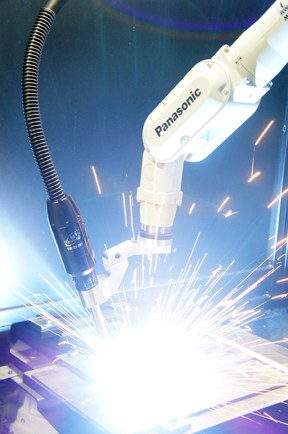
ways to increase throughput in their overall robotic welding process,
while also keeping costs low and quality on par. 1. Streamline in-house processes
2. Seek out industry experts
3. Analyze key cost drivers
4. Continue the process
How to Choose the Right MIG Gun Liner
How to Choose the Right MIG Gun Liner
Various types of liners for the job
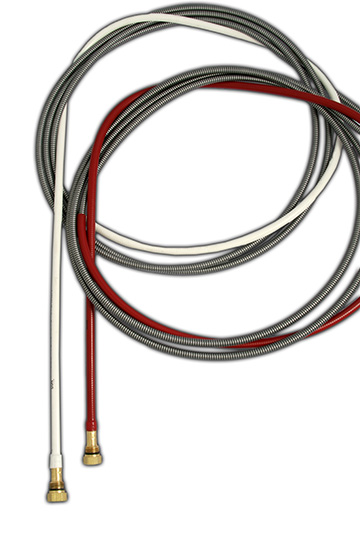
Closing thoughts
Tips for Proper Liner Installation to Help Optimize MIG Gun Performance
Tips for Proper Liner Installation to Help Optimize MIG Gun Performance
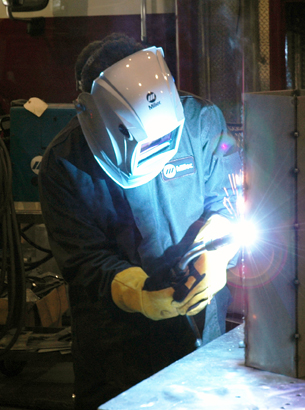
Various types of liners for the job
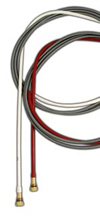
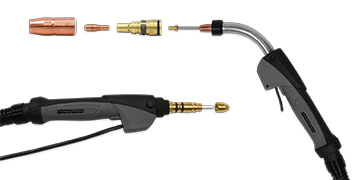
Step-by-step installation
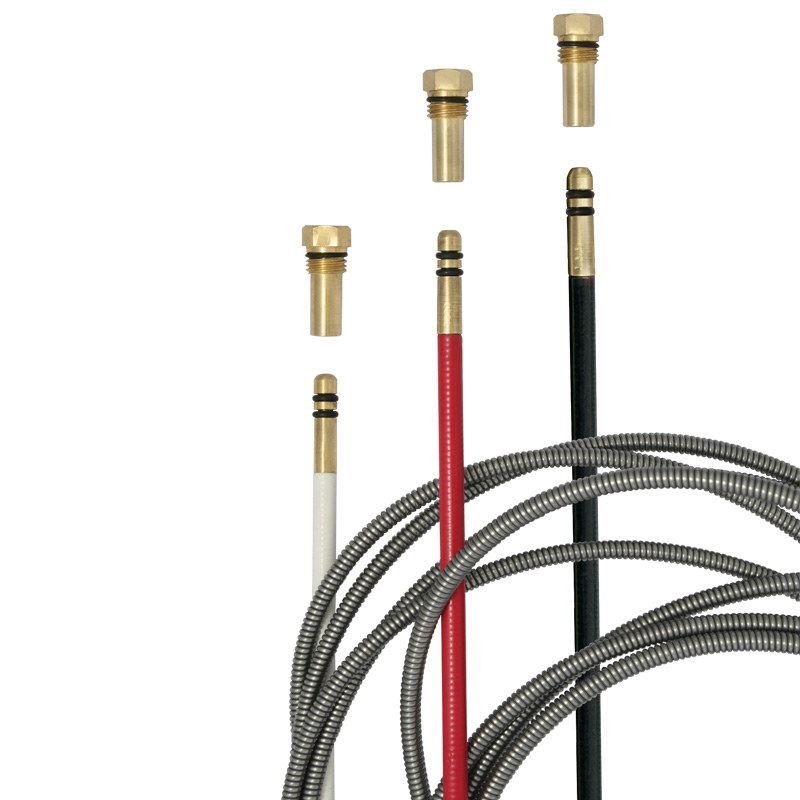
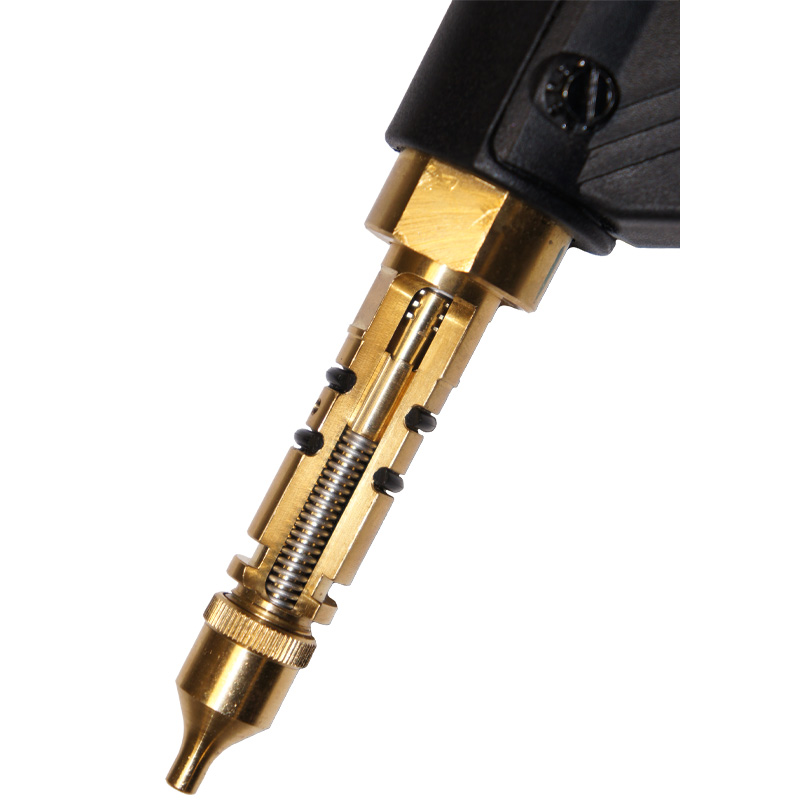
Proper liner installation can help optimize performance
Additional Resources
Consumables for High Amperage Welding: What to Know to Minimize Downtime, Costs and Quality Risks
Consumables for High Amperage Welding: What to Know to Minimize Downtime, Costs and Quality Risks
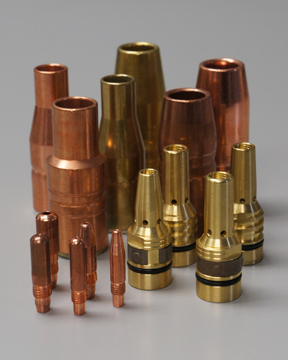
This article has been published as a web-exclusive on thefabricator.com. To read the entire article, provided by Dan Imus, Bernard and Tregaskiss account manager, please click here.
Selecting the Right Gun for MIG Welding Is Key to Achieving the Best Results
Selecting the Right Gun for MIG Welding Is Key to Achieving the Best Results
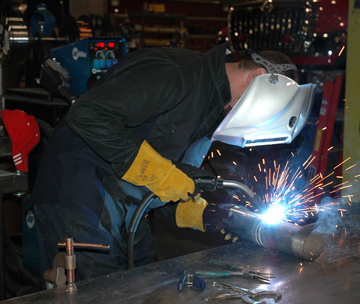
Selecting the right amperage
Choosing between light- and heavy-duty guns
Cooling options: air vs. water
Options for handles and cable selection
A side note on self-shielded flux-cored guns
The value of comfort
Gain Comfort, Productivity with the Right Welding Equipment
Gain Comfort, Productivity with the Right Welding Equipment
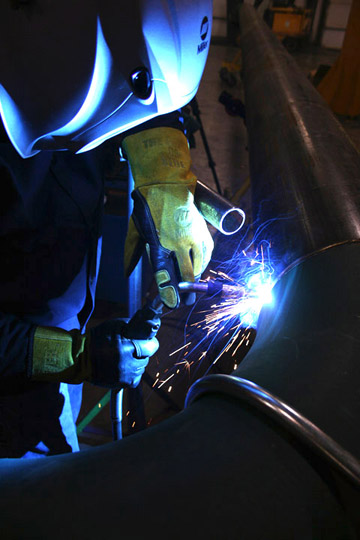
Don’t overdo the amperage
Picking the right handle
Reduce strain with the right neck
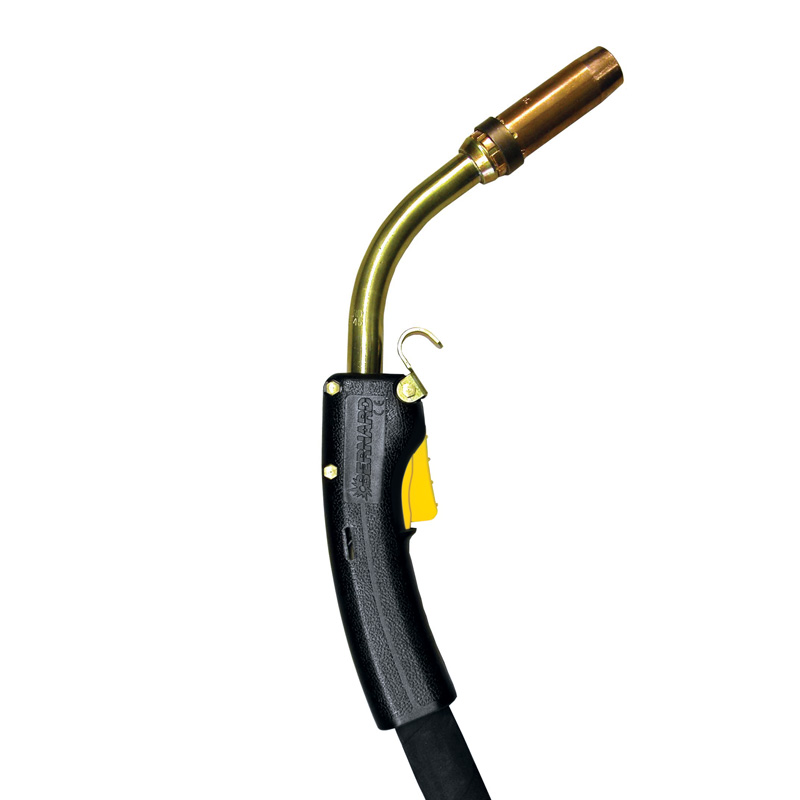
Benefits of shorter power cables
Other helpful tips
Parting thoughts
Tips for Selecting the Right Robotic MIG Gun
Tips for Selecting the Right Robotic MIG Gun
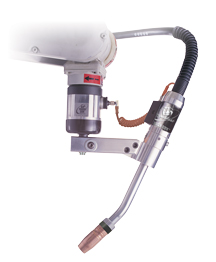
Air-cooled guns
Water-cooled guns
Hybrid air-cooled/water-cooled guns
Optional Robotic MIG Gun Features Can Improve Quality and Reduce Downtime
Optional Robotic MIG Gun Features Can Improve Quality and Reduce Downtime
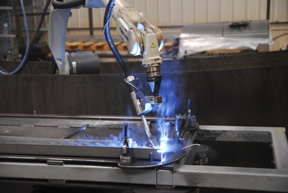
Benefits of the wire brake feature
When a wire brake offers advantages
Benefits of the air blast feature
Options that improve weld quality
5 Common Myths About Robotic Welding Systems
5 Common Myths About Robotic Welding Systems
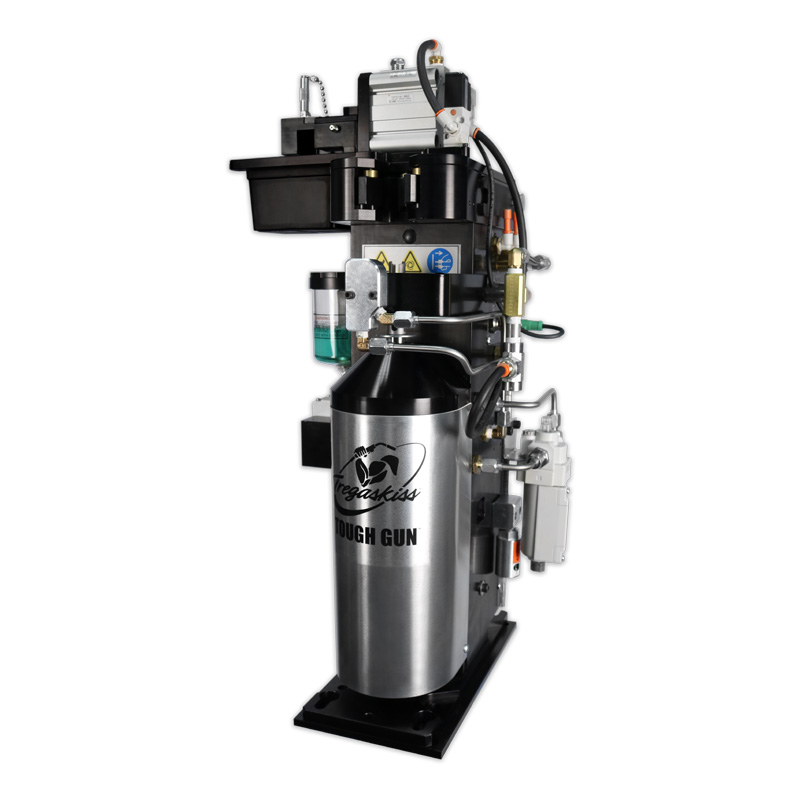
This article has been published as a web-exclusive on thefabricator.com. To read the entire story by Tregaskiss product specialist, Vic Lubieniecki, please click here.
Top Things to Teach a Robotic Welding Supervisor
Top Things to Teach a Robotic Welding Supervisor
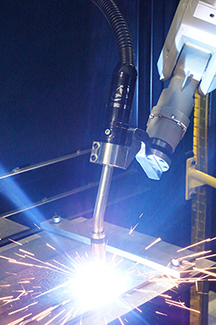
Tip No. 1: Understand the robotic welding system
Tip No. 2: Establish documentation, maintenance and control systems
Tip No. 3: Look for continuous improvements
Tip No. 4: Rely on the available resources
Making responsible decisions that lead to growth?
Premier Boat Fabricator Improves Productivity 25 Percent with New MIG Guns and Consumables
Premier Boat Fabricator Improves Productivity 25 Percent with New MIG Guns and Consumables

Gaining greater productivity

The Results
Selecting Consumables for Robotic Welding and Making Them Last
Selecting Consumables for Robotic Welding — and Making Them Last
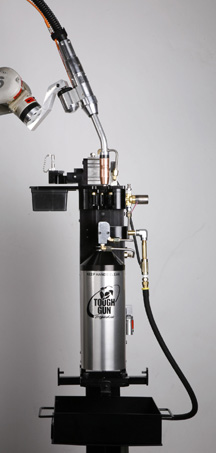
General selection considerations
Space and duty cycle factors
Nozzle maintenance
Storage and handling
Proper connections
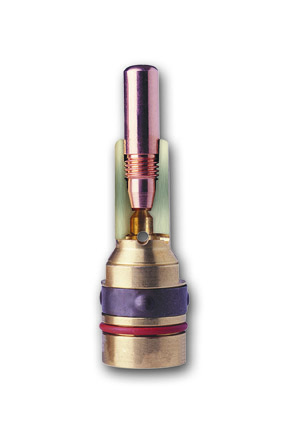
and gas diffuser (as shown in this cutaway)
help ensure reliable electrical conductivity
and minimize heat. The result is more
consistent weld quality and longer-
lasting consumables.Quality of Consumables Can Play a Role in Welding Productivity, Costs
Quality of Consumables Can Play a Role in Welding Productivity, Costs?
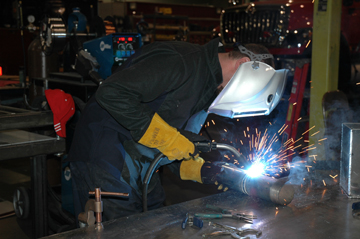
This article has been published as a web-exclusive on thefabricator.com. To read the entire story by Bernard design engineer Rob Centner, please click here.
Attacking Weld Fume at the Source
Attacking Weld Fume at the Source
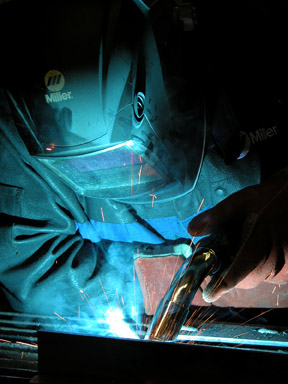
maintain compliance with safety regulations
and create a cleaner, more comfortable welding
environment. Proper use and maintenance of the
equipment is important to get optimal results.The basics
Benefits of fume extraction guns
Watch the degree of angle
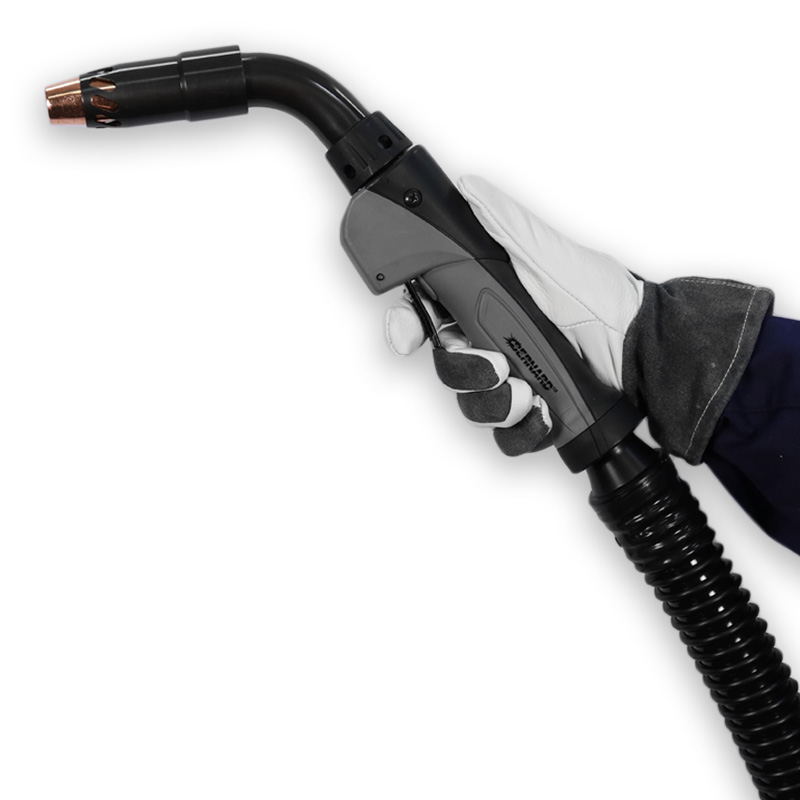
the welding process right at the source, over and around the weld
pool. As with any piece of welding equipment, fume extraction
guns benefit from preventive maintenance.Flux-cored wire allows vacuum adjustment
Pause at the end
Wire type determines stickout
Experiment with the air control regulator
Proper maintenance and consumable usage
Fume extraction guns can provide results
Preventive Robotic MIG Gun Maintenance: the Whos, Whens, Whys and Hows
Preventive Robotic MIG Gun Maintenance: the Whos, Whens, Whys and Hows
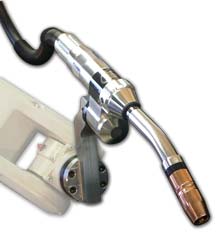
PM program basics: the whos and whens
Taking action: the whys and hows
Secure connections on a regular basis
Prevent spatter build-up
Mind the liner
Assess the welding cable and power pin
Parting thoughts on PM programs
From Technology to Technical Support: Welding in Today’s Automotive Industry
From Technology to Technical Support: Welding in Today’s Automotive Industry
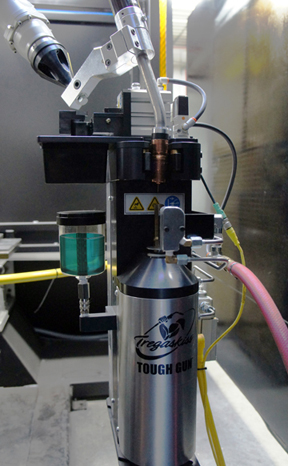
7 Ways to Save Money on Robotic Welding
7 Ways to Save Money on Robotic Welding
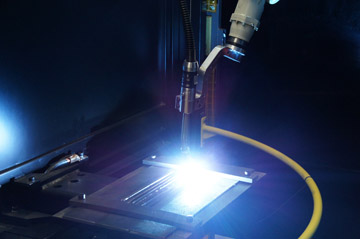
Tip No. 1: Add peripherals
Tip No. 2: Manage and maintain your consumables properly
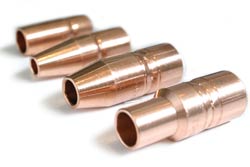
Tip No. 3: Implement a preventive maintenance program
Tip No. 4: Use the best filler metal package for the job

Tip No. 5: Select, trim and install the right MIG gun liner
Tip No. 6: Select the appropriate MIG gun
Having the right style and amperage MIG gun for the application can help minimize downtime for overheating and potential failure of this equipment. It can also save money by preventing the purchase of a larger (and more costly) gun than necessary for the job.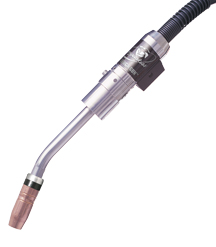
Tip No. 7: Take advantage of training opportunities
What You Should Know About Shielding Gas
What You Should Know About Shielding Gas
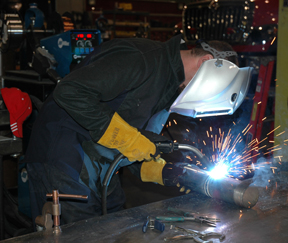
The role of shielding gases
Selecting the right shielding gas
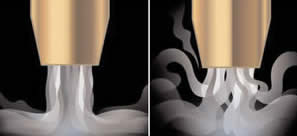
Tips for getting the most out of your shielding gas
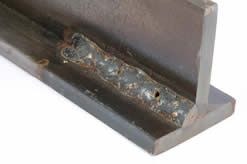
Emergency Vehicle Service Provider Gains Versatility, Comfort and More from New Welding MIG Guns
Emergency Vehicle Service Provider Gains Versatility, Comfort and More from New Welding MIG Guns

New guns offer greater versatility and comfort
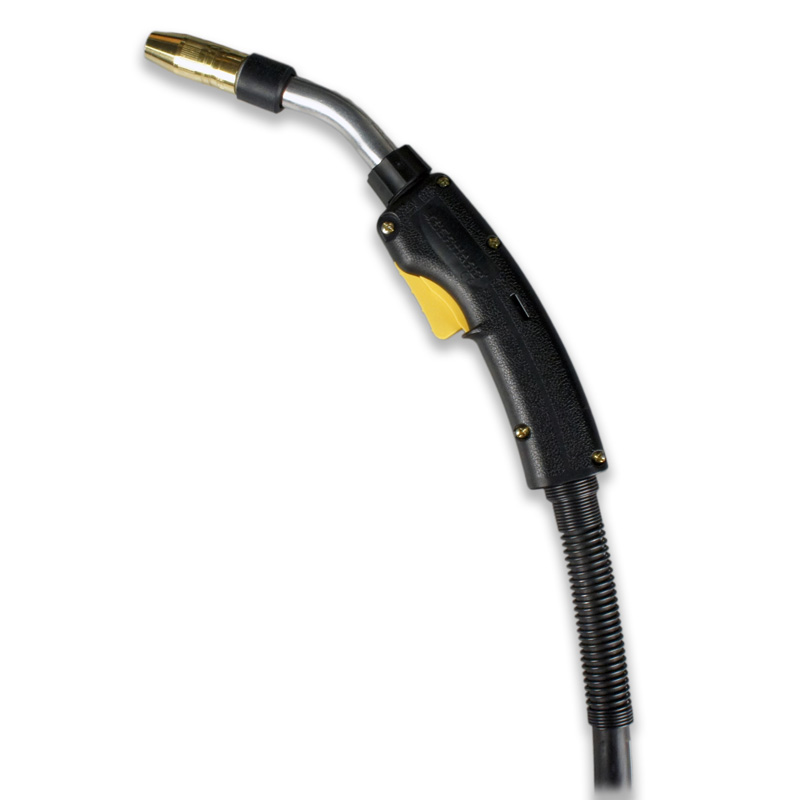
The added benefits of new consumables

Keeping the customer happy is priority No. 1
10 Money Saving Tips for Your Semi-Automatic MIG Guns
10 Money Saving Tips for Your Semi-Automatic MIG Guns
Tip No. 1: Protect Your Assets
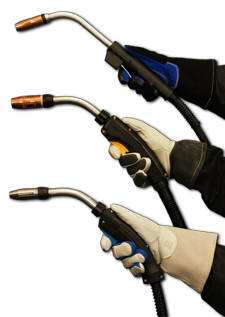
Tip No. 2: Get a Neck Up
Tip No. 3: Inspect, Clean and Tighten Regularly
Tip No. 4: Trim It Properly
Tip No. 5: Line It Up
Tip No. 6: Lighten Up
Tip No. 7: Stay Connected
Tip No. 8: Keep It Smooth and Clean
Tip No. 9: Size It Right
Tip No. 10: Think Long Term
7 Things To Know About Robotic Welding Systems
7 Things To Know About Robotic Welding Systems
1. Part repeatability is critical to successful automation
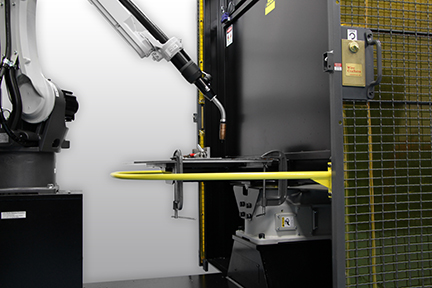
2. Training is essential
3. Additional safety equipment may be necessary
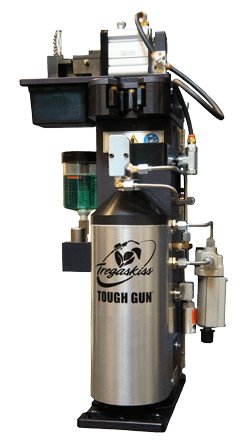
4. Weld data monitoring and/or peripherals can help improve results
Proper maintenance can help protect the investment in automation
6. Communication is key to proper weld quality and cost savings
7. Robots can do more than just weld
Preventive Maintenance Isn’t Just for Welding Robots
Preventive Maintenance Isn’t Just for Welding Robots
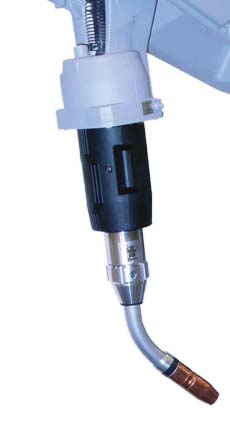
The Tasks
The Frequency and Scope
Jolson Welding
Heavy Structural Welding Simplified with Low-Speed Diesel Welder/Generators, Low-Hydrogen Flux-Cored Wire, Flux-Cored Guns and New Wire Feeding Technology
The System:
Advantages of Self-Shielded Flux-Cored Welding
Building a Welding System: The Power Source
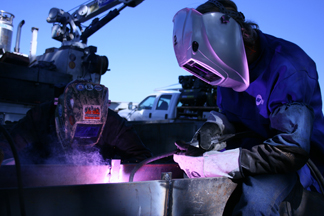
Wire Standardization Drives Quality, Productivity
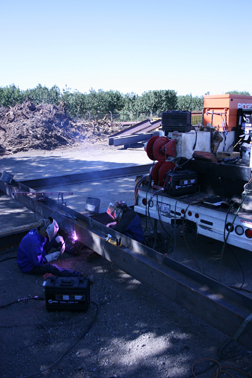
New Feeder Technology Improves Feeding Consistency
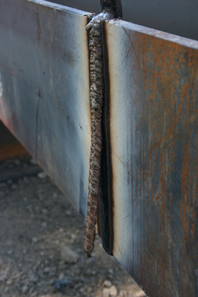
Setting Parameters Simplified Through Digital Meters, Wireless Remotes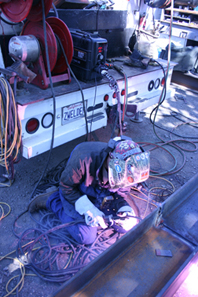
Specialized Flux-Cored Guns Take the Heat, Provide Optimal Comfort
robust design for working in hot and dusty outdoor applications.


